The blog visited the Noboribetsu Marine Park Nixe and Hokkaido Jingu Shrine, learning about Shintoism and its significance in Japan. It also made homemade ice cream at Lake Hill Farm using fresh Hokkaido milk. In Otaru city, it explored Sakaimachi Street's shops, cafes, and museums, including a Music Box Museum and a LeTao Desert Shop known for its delicious cheesecake.
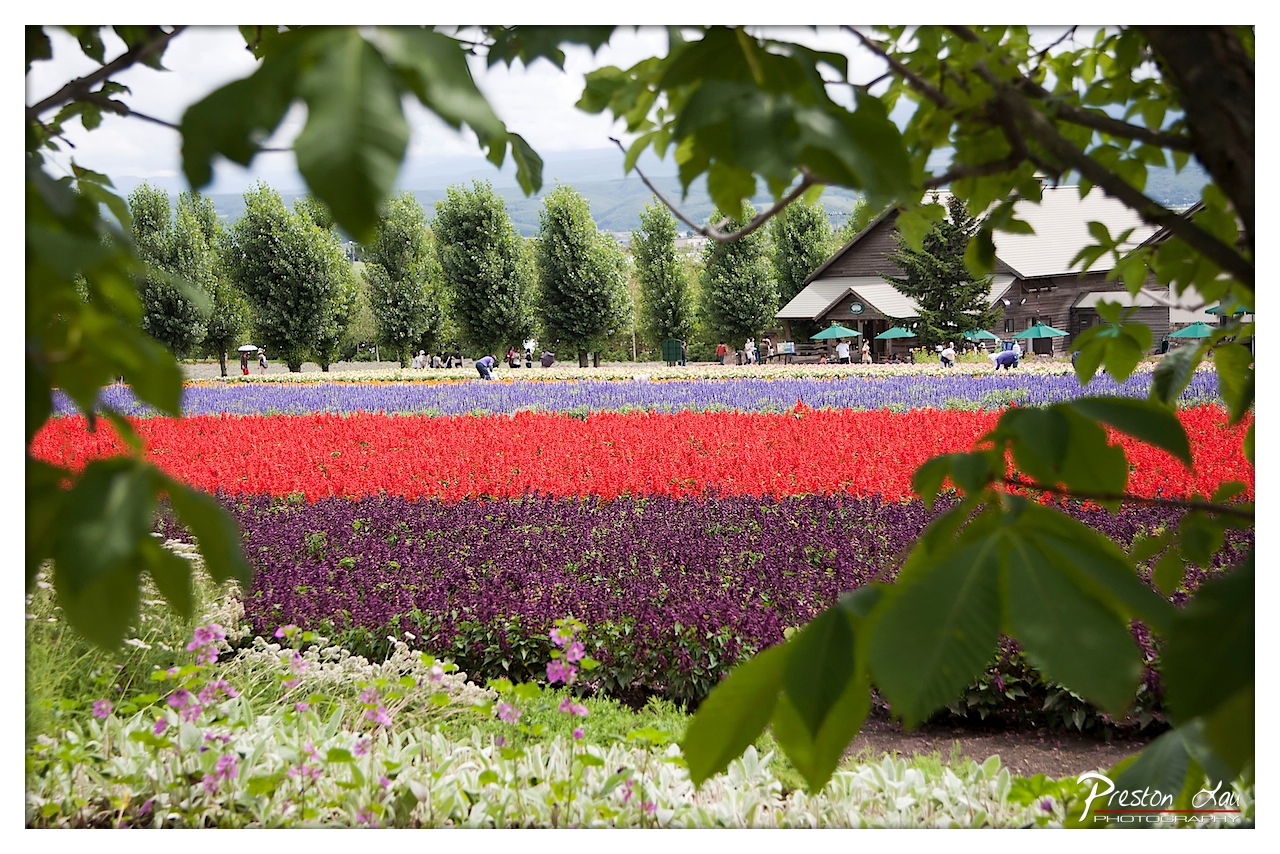

Rainbow Bloom Serenity
Rating: 9/10
This image presents a vibrant spectacle, capturing broad, horizontal stripes of brightly colored flowers stretching across the mid-ground, creating a visual feast for the eyes. The scene is bustling with life, showing numerous visitors strolling through the pathways or pausing to admire the floral display, adding a sense of scale and leisurely activity. The mood is distinctly cheerful and picturesque, evoking the simple pleasure of being immersed in natural beauty, enhanced by the charming wooden buildings nestled among the trees in the background.
From a photographic perspective, the composition employs a classic yet effective technique: framing the main subject with out-of-focus elements in the foreground – here, lush green leaves. This creates a sense of looking *into* the scene, drawing the viewer's eye towards the sharp, colorful flower stripes and the activity beyond. The strong horizontal lines of the flower beds act as powerful leading lines, guiding the gaze through the frame. The colors are incredibly saturated and striking, making the purple, red, and deeper tones pop against the green foliage and the somewhat muted background. While the lighting appears relatively flat, likely overcast or midday, it allows the flower colors to shine without harsh shadows. The background, complete with a line of trees, rustic buildings, and distant rolling hills under a soft sky, provides context and depth, grounding the floral extravaganza in a wider landscape. It’s a well-executed landscape shot, capturing a popular scenic spot with a touch of deliberate artistry through the framing.
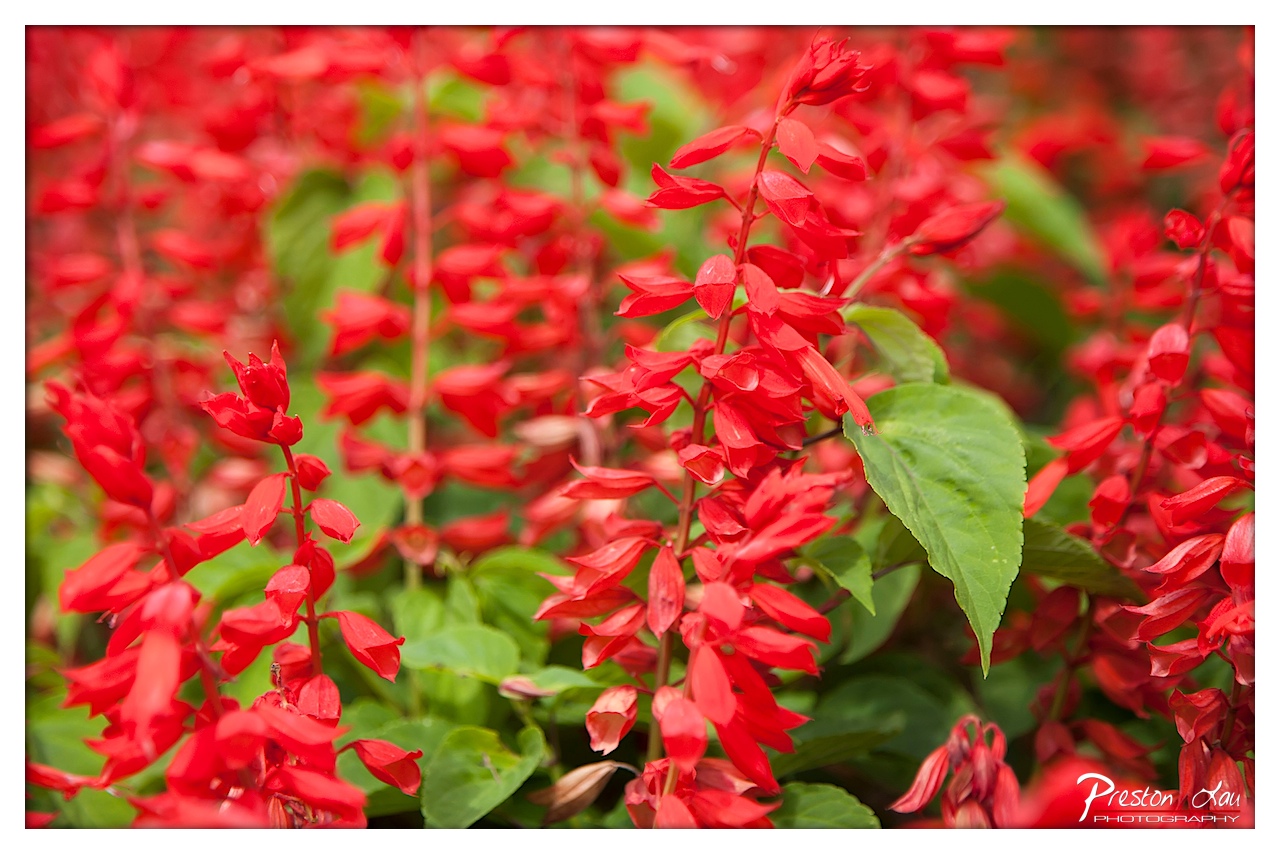

Red Alert: A Floral Overload
Rating: Subject: 8/10 (Points deducted for potential eye strain).
This image throws you headfirst into a sea of incredibly vibrant red flowers, which look suspiciously like Scarlet Sage (Salvia splendens). What's happening is essentially a full-frontal assault of crimson, captured with a shallow depth of field that makes the background melt away into a soft, painterly blur of red and green. The mood is undeniably energetic and intense, like a summer day shouting its colors from the rooftops, or perhaps a slightly alarming warning sign disguised as flora. The overall scene is a dense, colourful tapestry dominated by the fiery blossoms reaching skyward, softened slightly by the intermittent green foliage, all bathed in what appears to be pleasantly diffused natural light that allows those reds to sing without clipping.
From a photographic standpoint, this is a bold move – committing almost the entire frame to one high-saturation color. The composition uses the diagonal lines of the flower spikes to create a dynamic feel, leading your eye through the frame. The star of the technique here is the extremely shallow depth of field, which achieves that dreamy bokeh effect, isolating the sharp flowers in the middle while turning the rest into abstract shapes; it's so strong, you might wonder if the photographer was using a lens cap with a small hole! The large green leaf on the right provides essential contrast and a visual resting spot from the red onslaught. It's a classic close-up floral approach, focusing heavily on color impact and texture. The watermark sits discreetly in the corner, identifying the brave soul behind this explosion of scarlet. While technically well-executed, one can't help but feel slightly overwhelmed by the sheer *amount* of red – it’s like being trapped in a Rom-Com montage set in a flower field.
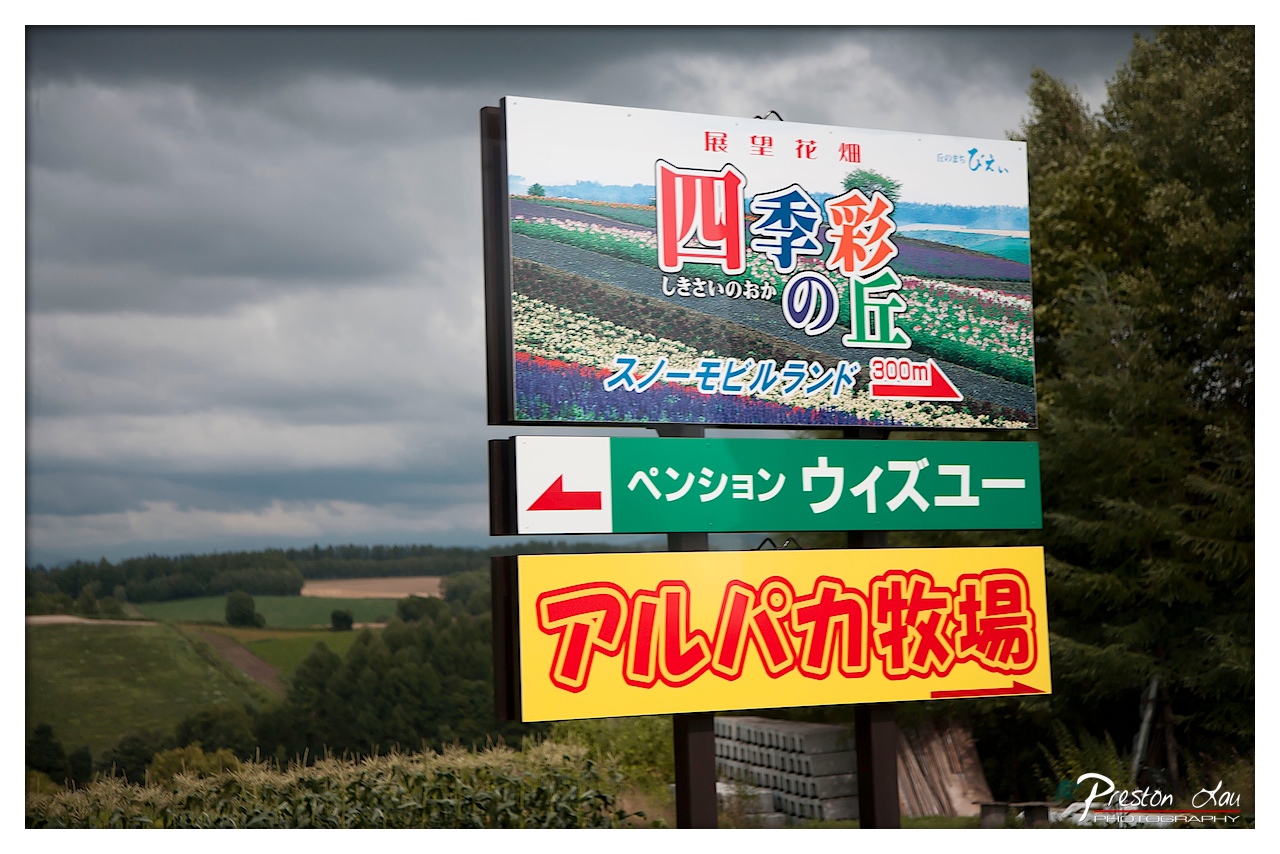

Pastoral Signage Under a Moody Sky
Subject Rating: 7/10
Behold, the veritable choose-your-own-adventure of rural Japan, condensed onto one signpost! This isn't just a sign; it's a promise of eclectic delights, from sweeping "Four Seasons Colored Hills" and the bracing thrills of "Snowmobile Land" (300m away, for those keeping score) to the cozy charm of a "Pension Wizu" and the undeniable appeal of an "Alpaca Farm." Seriously, who needs a grand architectural marvel when you can have alpacas and snowmobiles within spitting distance of each other? The scene is set under a dramatically moody, overcast sky that provides some lovely soft, diffused light – great for keeping the colors on those wonderfully vibrant signs from getting blown out, though it does lend a slightly somber tone to the otherwise pastoral backdrop of rolling hills and fields.
From a photographic standpoint, the composition leans the signpost slightly into the frame, adding a bit of dynamic energy, though perhaps a touch more foreground interest or a slightly wider view to anchor the scene might have been nice. The eye is naturally drawn to the bold, colorful signs, particularly the bright yellow "Alpaca Farm" with its welcoming red arrow, practically screaming "cuteness this way!". The soft light handles the colors beautifully, making the red, green, and yellow pop against the muted landscape. While the subject matter itself is functional signage, it tells a story about the location and serves as a focal point against the broader, somewhat indistinct rural scene. It's a candid snapshot capturing a very specific, wonderfully quirky piece of the travel experience – deciding which rural delight calls to you first.
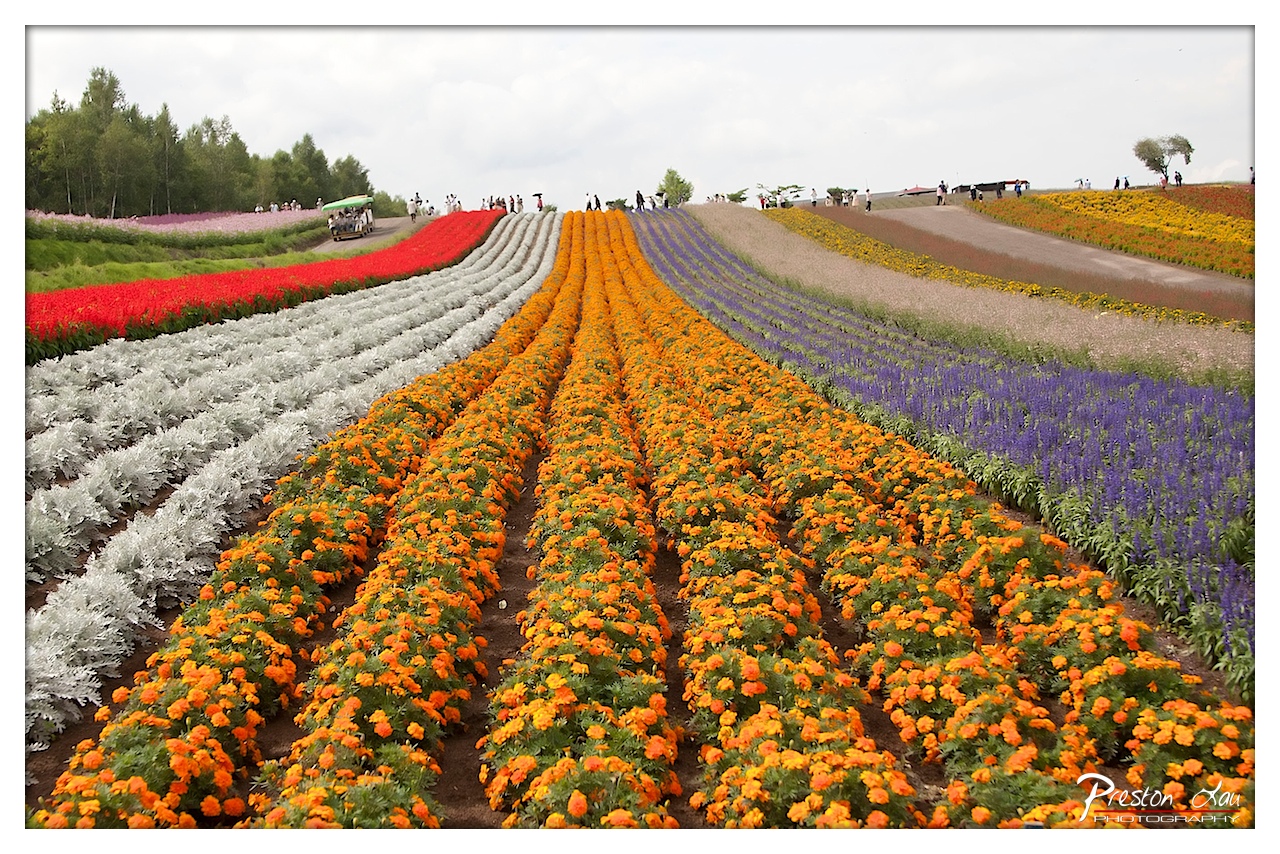

A breathtaking display of horticultural artistry awaits in this image, where rolling hills are transformed into vibrant ribbons of color. Subject rating: a resounding 9/10 – because who can resist fields of flowers planted with such meticulous precision? What's unfolding is a scene of pure visual delight: visitors are exploring this stunning floral landscape, some strolling along the paths, others enjoying a leisurely ride in a cheerful green cart, all set against a backdrop of seemingly endless blooms. The mood is one of joyful serenity, a vibrant celebration of nature's palette expertly arranged by human hands. The composition is a masterclass in using diagonal lines; the stripes of red, silver, and especially the prominent orange guide the eye deep into the frame, creating a fantastic sense of depth and leading the viewer through the floral tapestry.
The lighting, soft and diffuse under a cloudy sky, is excellent for showcasing the intensity and variation of the colors – from the fiery reds and sunny oranges to the cool silvers and deep purples further back – without the harsh shadows that direct sunlight would cast. While a touch more contrast or the warm glow of a different time of day might appeal to some, this lighting perfectly preserves the richness of every petal. The background seamlessly extends the pattern, adding scale to the scene and grounding it with a line of trees on the horizon and a lone, picturesque tree on a distant hill. This is a classic piece of landscape photography, leaning into the power of color and pattern to create an overwhelmingly positive and beautiful image that almost makes you smell the blossoms.
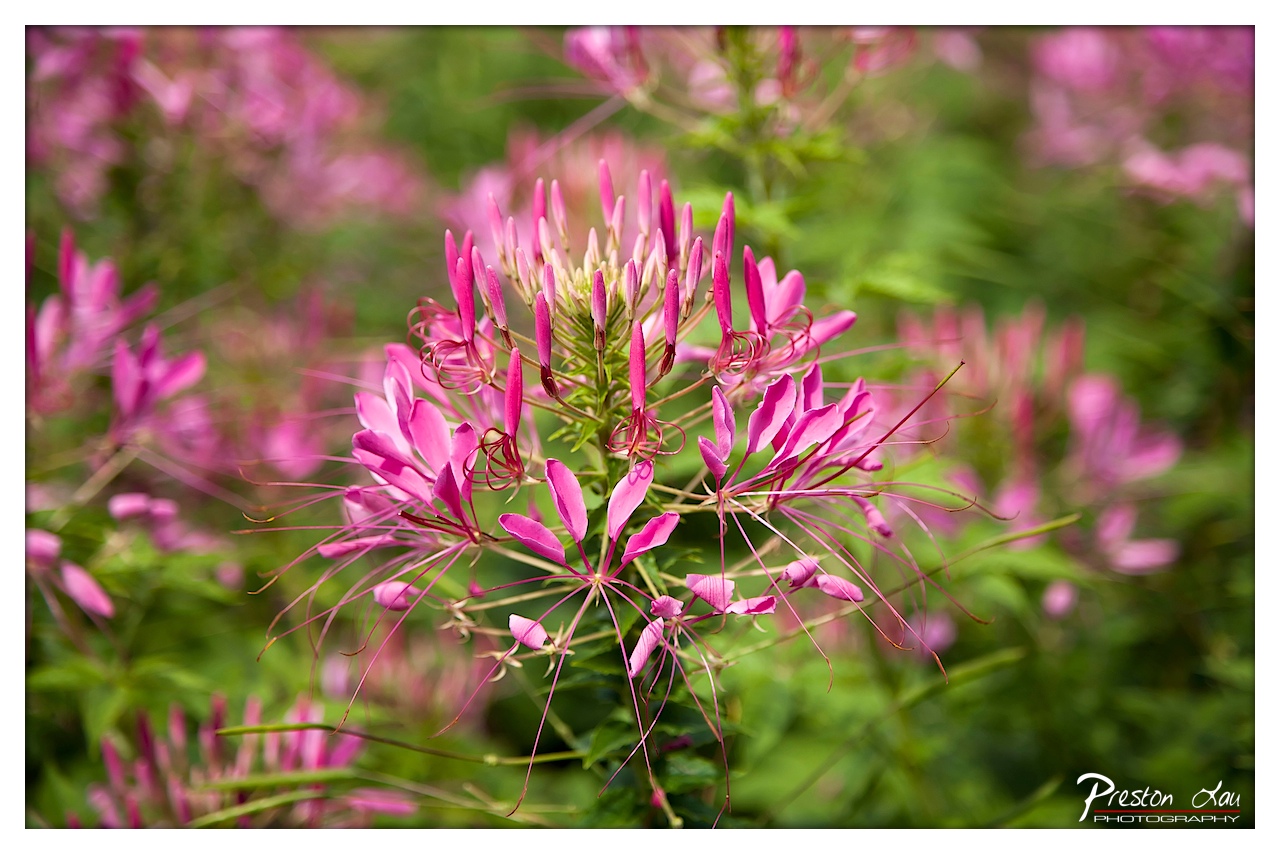

Cleome Calling
Rating: 7/10
Alright, let's talk about this spiky spectacle. We've got ourselves a beautiful, somewhat alien-looking Cleome (Spider Flower) taking center stage, demanding all your attention with its wild, spindly stamens that seem to be reaching out for a high-five or maybe just trying to trip nearby insects. What's happening? It's just being fabulous in full bloom, showing off its vibrant pink petals and that surprisingly dense, almost cone-like cluster of buds at the top, like a tiny floral crown. The mood is definitely one of natural beauty and perhaps a touch of botanical eccentricity. This isn't your average shy wallflower; this bloom is here to make a statement, and its complex structure makes for a visually intriguing subject matter, easily scoring it a respectable 7 for sheer charisma.
From a photography standpoint, the composition is focused squarely on the main event, placing the primary flower cluster slightly off-center, which adds a touch more dynamism than a dead-center shot. The lighting appears soft and natural, highlighting the delicate textures of the petals without harsh shadows. The color palette is a winner – the vivid fuchsia of the flower pops magnificently against the soft, dreamy bokeh of the green background. This shallow depth of field is absolutely crucial in this style of close-up nature photography, effectively isolating the subject and making the busy background melt away into pleasant blobs of color. It’s a classic technique, executed well, letting those peculiar stamens really stand out in their spidery glory. And of course, proudly guarding the bottom corner, we have the artist's signature – Preston Lau Photography – just in case you weren't sure who wrangled this botanical beast into submission for its close-up.
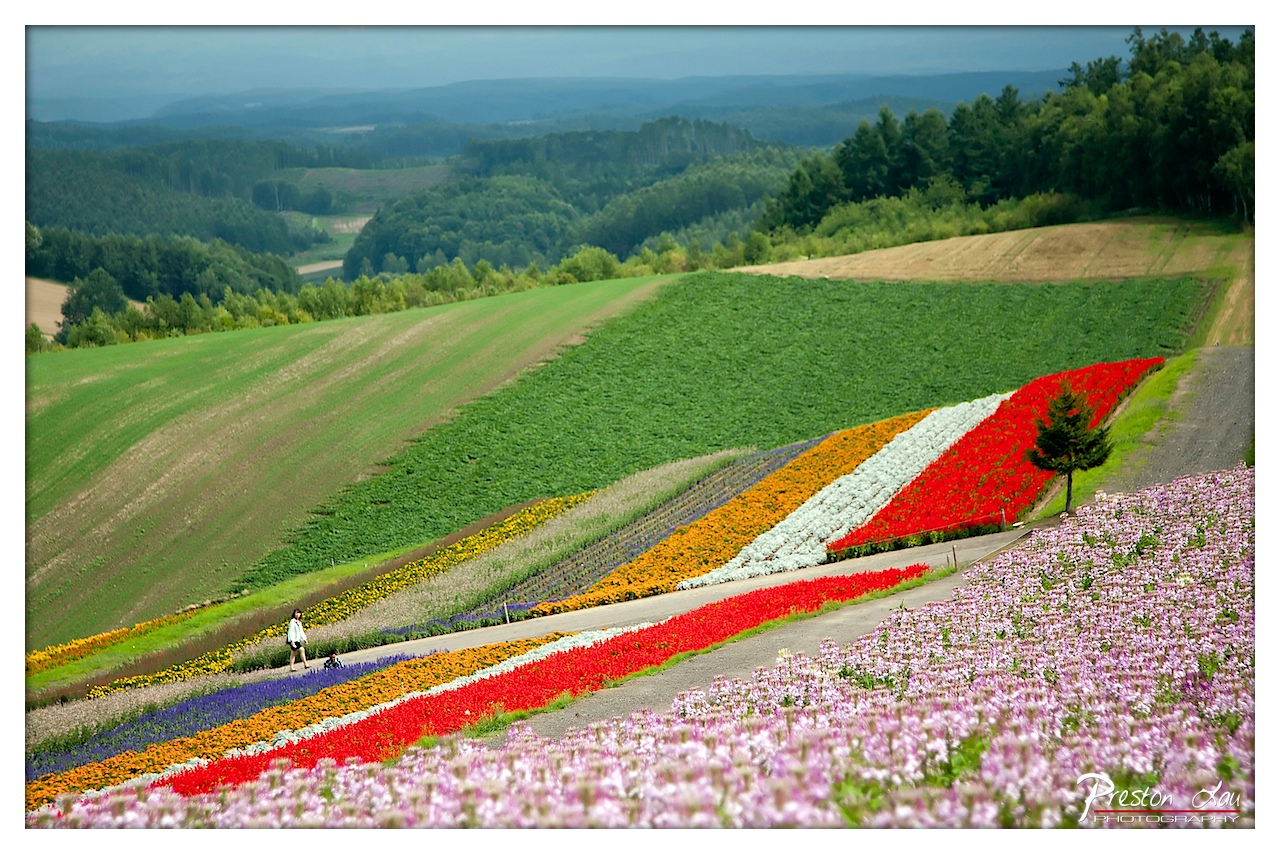

Hillside Hue Heaven
Rating: 9/10
Well, someone certainly got the memo about 'painting with all the colors of the wind'... and then some! This image screams "peak flower power" with its intensely vibrant stripes cascading down a rolling hillside like a rainbow that decided to settle down and grow roots. We're presented with an epic vista of meticulously planted flowers in bold bands of purple, blue, yellow, orange, white, and red, leading the eye towards a distant lone tree standing guard over the scarlet blooms. A solitary figure, dwarfed by the floral grandeur, ambles along a path with a small companion, adding a crucial sense of scale to this overwhelming display of nature's (and likely a dedicated gardener's) artistry. The mood is undeniably cheerful, awe-inspiring, and perhaps just a touch dizzying from the sheer visual intensity.
From a photography perspective, the composition is a winner, employing strong diagonal lines formed by the flower rows to create dynamic movement and lead the viewer deep into the scene. The high horizon pushes the focus onto the patterned landscape below, which is exactly where the action (the color!) is. The lighting is soft and even, perfect for saturating those colors without blowing out highlights or creating harsh shadows. While the foreground pink flowers are beautifully blurred into bokeh, one might wonder if the true focus was intended to be on the sharp lines of the main color bands further up – an artistic choice or a slight miss? The inclusion of the tiny person and dog is a smart move, providing a relatable element and emphasizing the vastness. The background of soft green fields and hazy hills offers a calming counterpoint to the riot of color in the foreground, proving that sometimes, less really is just... green.
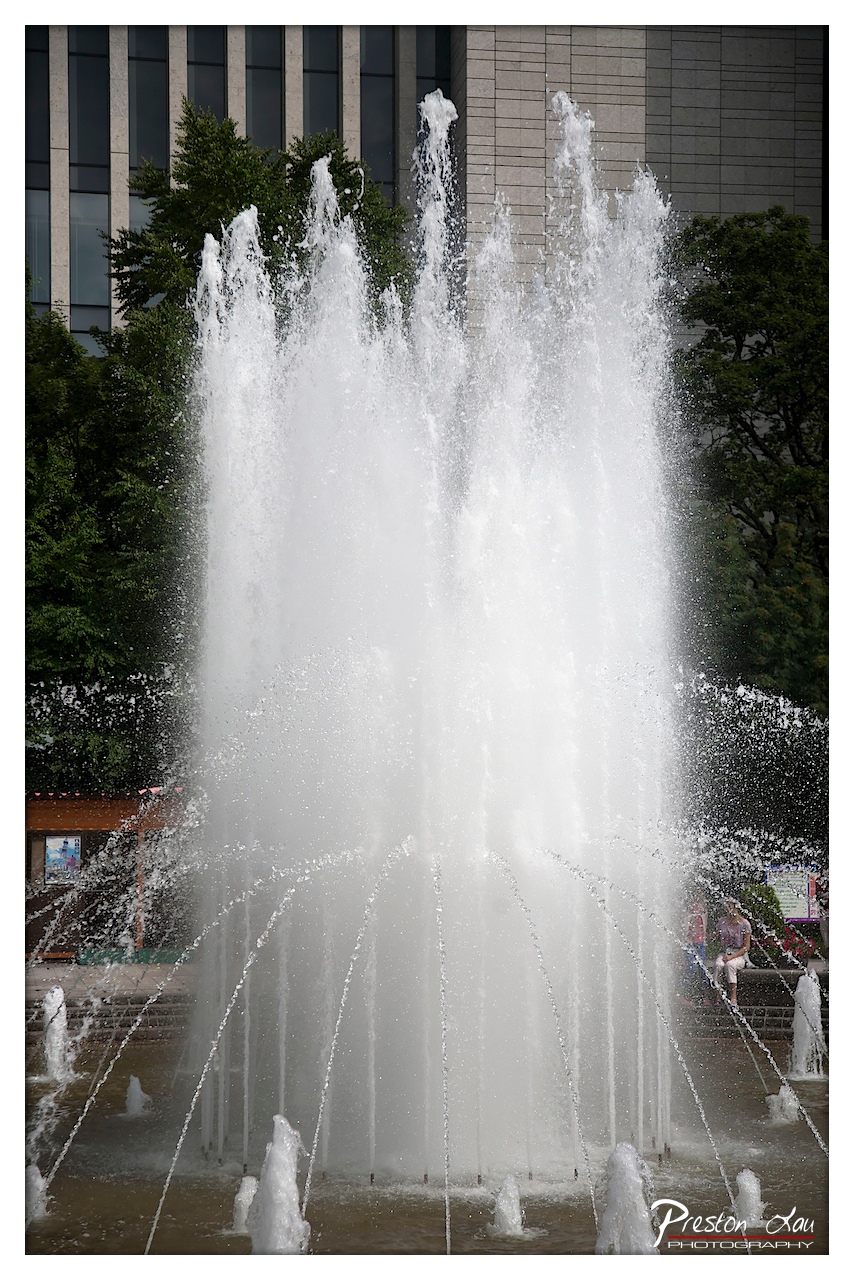

The Liquid Curtain
Rating: 7/10
This image captures a magnificent urban fountain at its peak performance, rated a solid 7/10 for sheer watery spectacle. What's happening is a powerful eruption of water jets, forming a dense, almost opaque wall of spray in the center, flanked by smaller, arcing streams. The mood is one of refreshing dynamism and power, suggesting a hot day where the cool mist is a welcome sight. The composition places the fountain front and center, practically filling the frame vertically, which effectively conveys the scale and height of the main jet, though it leaves little room to breathe around the edges, making it feel a tad confined. It's a straightforward, head-on approach that focuses entirely on the water's display.
Looking closer, the lighting is clearly bright, emphasizing the dazzling white of the water spray and highlighting individual droplets like scattered jewels. The color palette is rather muted, dominated by the white of the water, the grey tones of the background building, and the green of the trees, keeping the focus squarely on the aquatic subject matter. In the background, we see a modern building with vertical elements and stone cladding, along with lush green trees offering a natural counterpoint to the architecture. Vague figures of people are visible on steps near the edges, providing a sense of scale and hinting at the location being a public space – perhaps seeking refuge from the heat or simply enjoying the view (and hopefully not getting too soaked). The signature adds a personal touch, identifying the artist behind this capture of a temporary, ever-changing liquid sculpture.
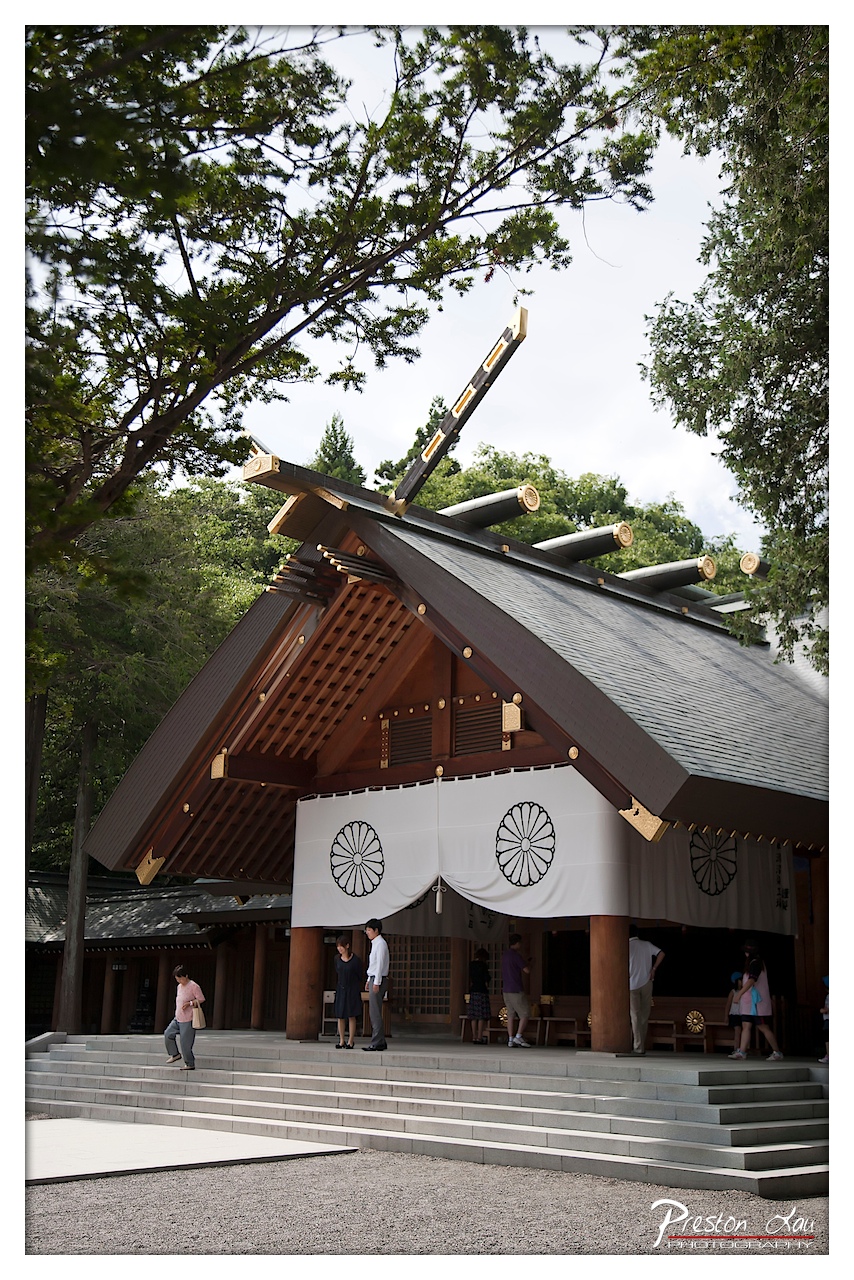

Zen and the Art of Shinto Architecture
Rating: 8/10
Ah, the classic Japanese shrine shot! Here we have a magnificent example of traditional Shinto architecture, looking all serene and important, perched atop a grand set of stone steps. The main subject is clearly the shrine building itself, with its imposing multi-layered roof adorned with distinctive Katsuogi (the log-like elements) and Chigi (the V-shaped elements reaching skyward). Below, a large white curtain, perhaps a *noren* or *agemaki*, hangs prominently, decorated with the striking chrysanthemum emblem, the Imperial Seal of Japan. A handful of people mill about on the platform before the entrance and on the steps, adding a sense of scale and gentle activity – one person is carefully descending the stairs, another couple stands chatting, and a few figures are visible inside the entrance area. The mood is one of quiet reverence and perhaps a touch of tourist curiosity, set against the backdrop of lush green trees under a bright, diffused sky. It’s a scene steeped in history and calm, beckoning visitors to step closer and pay their respects (or just admire the craftsmanship).
From a photographic perspective, the composition is a bit of a wrestle between the grand architecture and the natural elements. The sweeping branch of the tree in the upper left provides some natural framing, but it feels slightly heavy and perhaps unintended, fighting for attention with the sharp lines of the roof. The steps create a strong leading line, effectively drawing the eye towards the main entrance, although they occupy a significant portion of the lower frame. Lighting appears soft and even, suggesting it might be a cloudy day or early/late sun, which prevents harsh shadows but also results in somewhat flat tones. Color-wise, the rich brown of the wood and the dark roof contrast nicely with the bright white curtain and the vibrant green foliage. The photographer seems to have gone for a slightly low angle, emphasizing the height and complexity of the roof structure. While the architecture is undoubtedly impressive and the scene culturally rich (earning its 8/10 subject rating), the slightly unbalanced composition and the presence of the watermark suggest a candid travel shot rather than a meticulously planned architectural study.
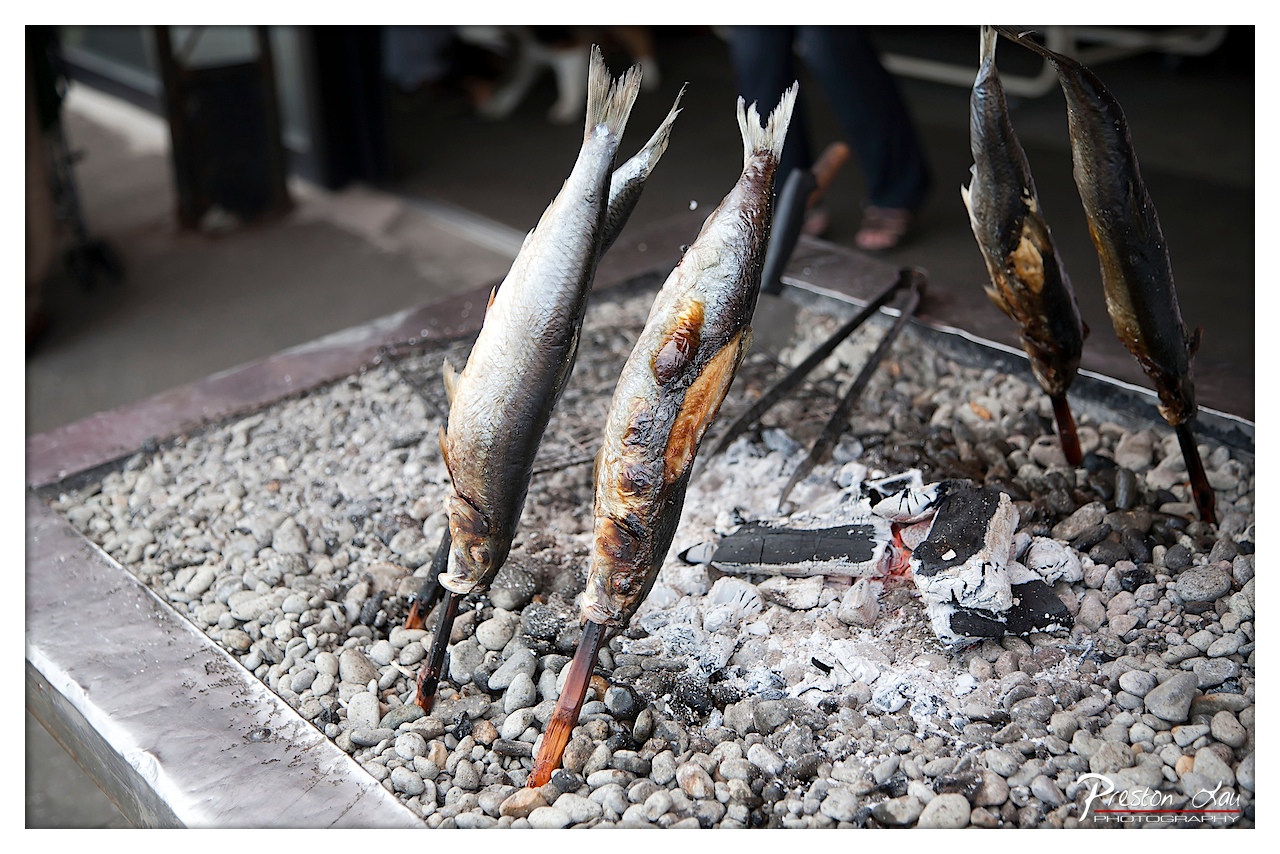

Title: Stone-Grilled Fishy Business
Rating: 8/10
Ah, the classic "fish on a stick over hot rocks" technique. It's simple, it's primal, and frankly, it looks a little uncomfortable for the fish, but probably delicious for the eventual consumer. Here we have four poor souls elevated vertically, getting a nice char over a bed of what appears to be river stones and glowing coals. Two are looking rather silvery and fresh, while the other two have embraced the smoky fate, turning a lovely shade of grilled brown. Tongs stand ready, likely for rotating duties or perhaps a mercy rescue, while chunks of partially combusted charcoal add to the rugged, outdoor cooking vibe. This setup screams traditional, rustic, and definitely not "dishwasher safe."
From a photographic standpoint, the composition is quite dynamic, with the fish skewers creating leading lines and varying heights, adding visual interest to what is essentially a pile of rocks. The shallow depth of field beautifully isolates our finned friends from the background, which is a blur of indistinct shapes, hinting at people and an outdoor space – perhaps a bustling market or a roadside stall where this culinary theatre is unfolding. The lighting is natural and gives the fish a nice glint, while the embers provide a warm counterpoint to the cool grey stones. The focus is spot-on, capturing the textures of the scales, the char, and the rough pebbles. Overall, it's a well-executed shot that captures a moment of simple, albeit vertical, grilling goodness, complete with a stylish photographer's watermark ensuring everyone knows who documented this momentous piscine event.
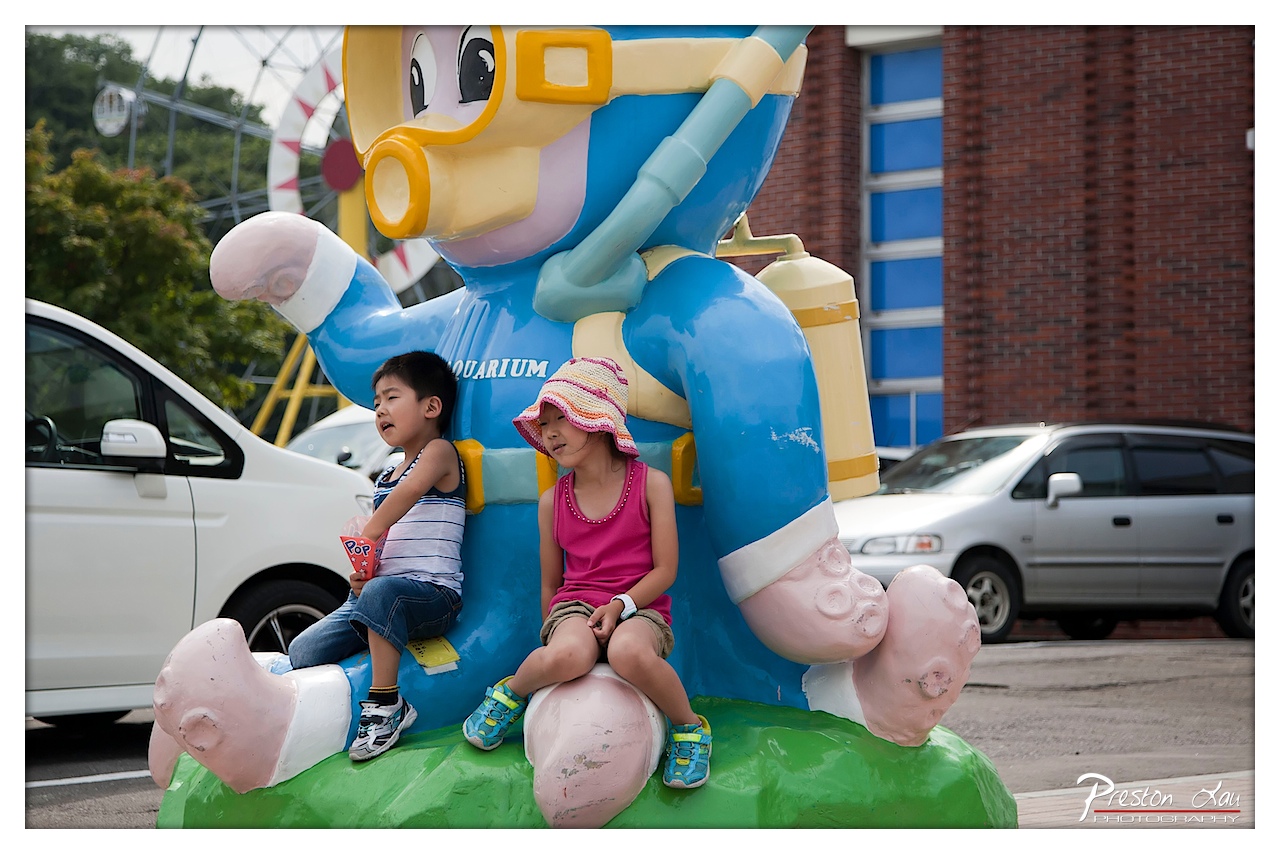

Knee-Deep in Boredom on a Giant Diver
Subject Rating: 8/10
Here we have a truly epic scene: two young adventurers, looking remarkably unimpressed, perched upon the gargantuan knee of a friendly neighborhood diver mascot. It appears they've landed on a rather comfortable, albeit slightly scuffed, pink mound protruding from the larger-than-life blue figure. One child idly clutches a bag of popcorn, perhaps contemplating the meaning of existence or just waiting for more butter. The mood is one of casual waiting, maybe a touch of weary resignation, perfectly contrasting with the mascot's perpetually cheerful, wide-eyed stare and its optimistic "AQUARIUM" chest plate. Clearly, someone is having more fun than the others (spoiler: it's probably the mascot, existing solely to be sat upon).
From a photographic perspective, the composition is low and wide, emphasizing the scale of the mascot's lower half and placing the slightly bored subjects squarely in the frame. The relatively shallow depth of field effectively blurs out the busy background – a mix of cars, a brick building with blue-paned windows, distant trees, and a Ferris wheel peeking over the top – ensuring our focus remains steadfastly on the children and their giant, blue companion. The natural daylight provides decent, soft illumination, highlighting the vibrant colors of the children's clothing and the mascot's suit against the more subdued backdrop. It's a straightforward environmental portrait, capturing a moment of stillness (and likely impatience) amidst what appears to be a public attraction area. The style leans towards a candid feel, capturing the children as they are, unposed, lost in their thoughts... or just bored stiff by the colossal knee beneath them.
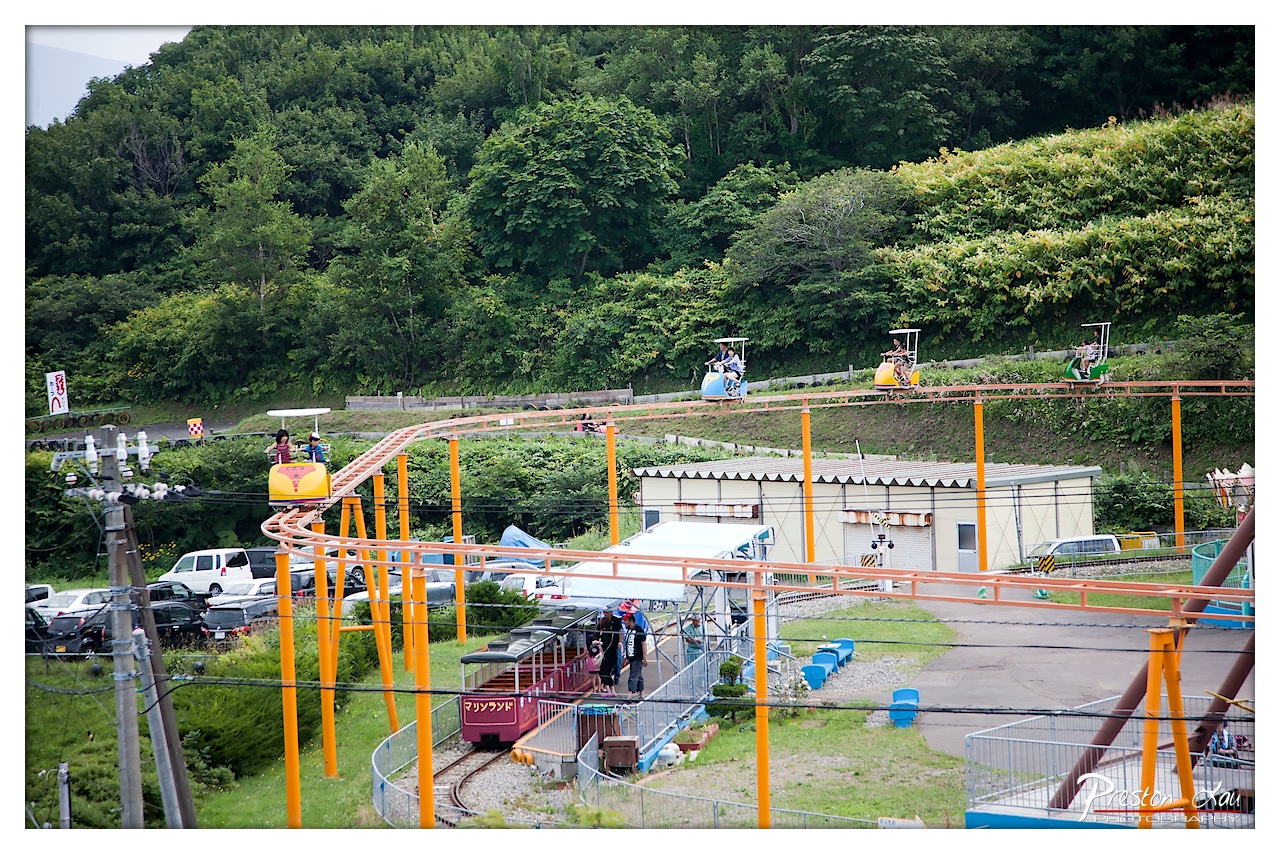

Gentle Thrills Amidst the Green
Subject Rating: 7/10
This image captures a charmingly low-key amusement park nestled against a lush, green, forested hillside. It seems like a place where speed isn't the main attraction, but rather a pleasant day out enjoying simple rides. We see multiple colorful cars on a raised track, resembling a very mild roller coaster or perhaps a self-propelled ride, meandering through the scene. Further below, a miniature red train labeled "Marinland" sits at a station, ready for passengers. People are visible on the rides and at the station, adding a sense of scale and activity to the park which is composed of modest buildings and tracks supported by bright orange poles. The overall mood is relaxed and perhaps a little nostalgic, reminiscent of a bygone era of family-friendly fun without the overwhelming scale of modern theme parks.
From a photographic standpoint, the composition utilizes the orange track as a strong leading line, drawing the eye into the scene from the foreground. The background of dense green forest provides a nice contrast and natural backdrop to the manufactured elements of the park. The lighting appears soft and diffused, likely from an overcast sky or later in the day, which prevents harsh shadows but also flattens the image somewhat. The photographer has chosen a wide shot to encompass the scope of the park within its environment, though the busy foreground with parked cars and infrastructure slightly competes for attention. The subject matter itself, a slightly dated amusement park, offers interesting visual elements, particularly the bright colors of the rides against the natural greens and muted building tones. It's a capture that feels honest and documentary, showcasing the scene as it is, inviting the viewer to imagine a quiet day spent here.
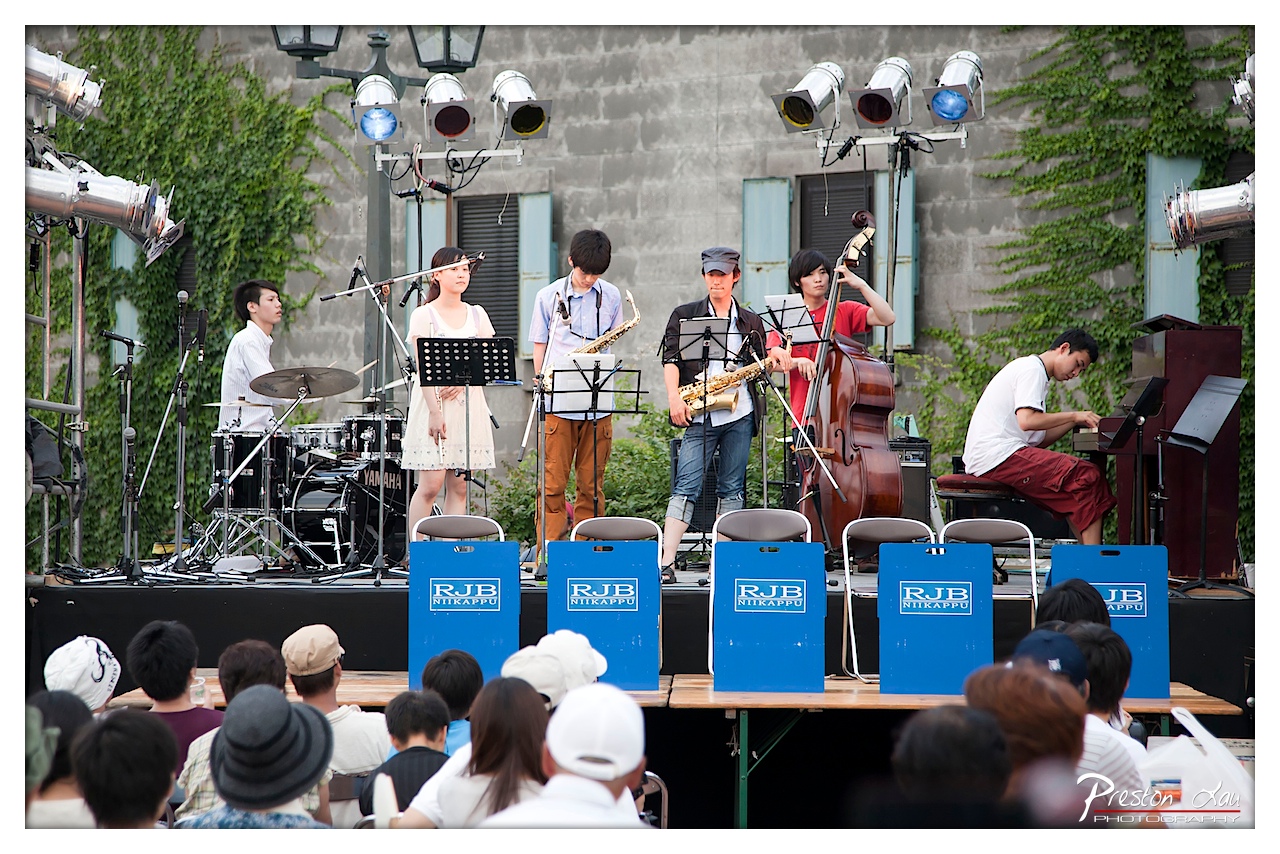

Outdoor Summer Jam
Subject Rating: 7/10 - A lively scene capturing a live musical performance, packed with instruments and people, though the overall composition feels a touch static.
This photo transports us to an outdoor stage bathed in a mix of natural light and theatrical spots, where a band is mid-performance. The mood is relaxed and engaging, suggesting a community event or festival performance on a pleasant day. The band features a classic lineup: a drummer intently focused behind a Yamaha kit, a flutist in white, two saxophonists (one alto, one tenor), an upright bassist providing the low end, and a pianist seated at a keyboard setup. Each musician is positioned with their music stand, ready to deliver their parts. In the foreground, a portion of the audience is visible, seated and enjoying the show, adding a layer of authenticity and scale to the scene. The stage itself is set against a charming backdrop of a building wall largely covered in vibrant green ivy, with a couple of blue-shuttered windows peering through the foliage. Prominently displayed at the front of the stage are several bright blue signs bearing the logo "RJB NIIKAPPU," adding a splash of contrasting color and perhaps indicating a sponsor or location.
From a photographic perspective, the shot effectively documents the event, capturing the full breadth of the stage and some of the audience interaction. The composition places the stage centrally, allowing viewers to take in the entire band setup, the background, and the lighting rig above, which features several spot lights. The lighting, while functional, lacks dramatic punch, resulting in a somewhat flat illumination of the performers, although the blue stage lights add a nice accent on the left. The color palette is dominated by the earthy greens of the ivy, the grey of the building, and the strong blue of the signs, which almost steal the show from the musicians – perhaps the signs needed their own spotlight! The style is straightforward and documentary, capturing the scene as it is without heavy artistic interpretation. While it serves its purpose of recording the event, a photographer looking to make a more impactful image might consider tighter framing on individual performers, experimenting with lower angles, or waiting for moments of more dynamic action or interaction within the band or between the band and the audience. Still, it’s a solid capture of an enjoyable outdoor concert.
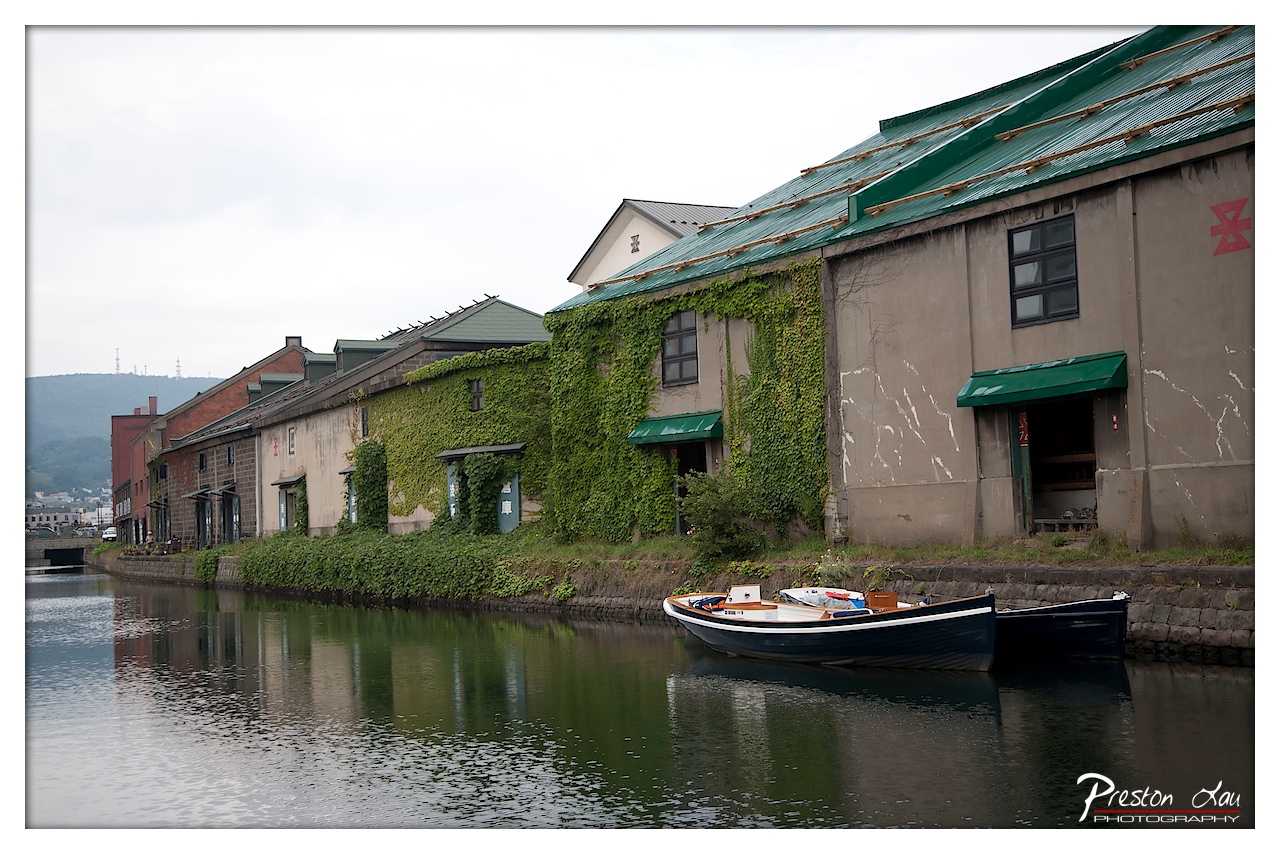

Ivy-Clad Chronicles by the Canal
Subject Rating: 8/10
This image transports us to a calm canal scene lined with sturdy, historical warehouses. On the right, a row of buildings stands guard, their reflections shimmering in the still water. The most prominent among them is heavily draped in vibrant green ivy, clinging to its weathered stone like a natural blanket. Two small, dark boats are moored peacefully in the foreground, adding a touch of scale and suggesting quiet passage. The overcast sky lends a soft, diffused light to the scene, muting the colors and enhancing the overall serene, slightly melancholic atmosphere. It feels like a place where time moves slowly, perhaps whispering tales of a busy past when these canals were bustling arteries of commerce.
From a photographic perspective, the composition uses the converging lines of the canal and the buildings effectively to draw the viewer's eye into the depth of the scene. The reflection in the water is a fantastic element, mirroring the architecture and adding a layer of visual interest, though the slightly rippled surface prevents a perfect, perhaps less dynamic, mirror image. The lighting, while flat due to the cloudy sky, is great for capturing detail across the buildings without harsh shadows, though it sacrifices dramatic highlights. The color palette is dominated by earthy tones and muted greens, with the bright green roofs providing a touch of visual energy. It’s a classic travel photography shot, capturing the essence of a historical location with a quiet, contemplative mood, perfectly signed off in the bottom right corner.
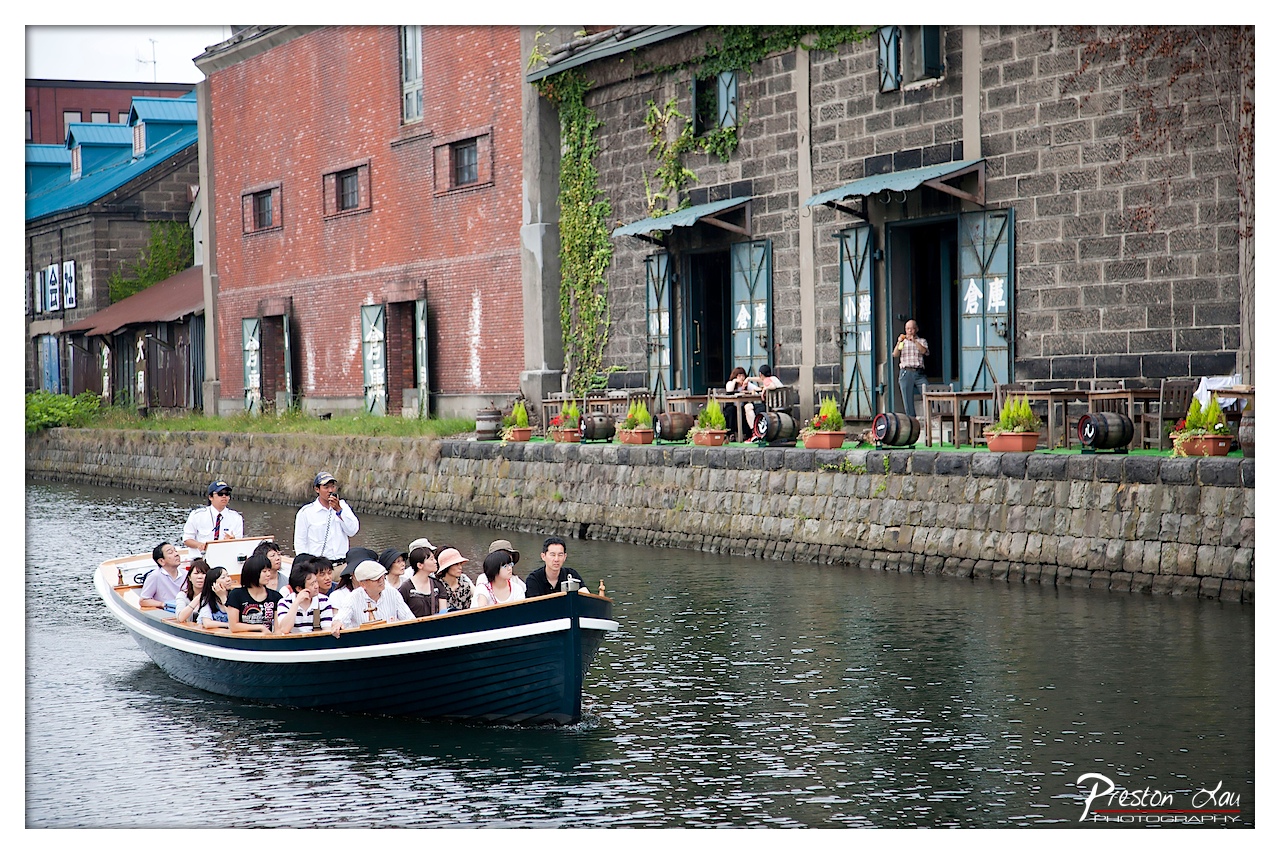

Canal Cruise Chronicle
Subject Rating: 8/10
Ah, the quintessential tourist experience: a boatload of eager adventurers navigating a historic waterway! Our subject, a sleek vessel teeming with sightseers, is expertly captured as it glides along the canal. The guide, microphone in hand, appears to be either delivering fascinating historical facts or auditioning for a rap battle – it's hard to tell from this distance, but the energy is palpable! Packed shoulder-to-shoulder, these explorers are soaking in the atmosphere of what looks like a charming old port town, lined with sturdy brick and stone warehouses dating back to a bygone era. Some buildings sport weathered blue shutters and decorative elements, hinting at stories untold, while others are partially covered in climbing greenery, adding a touch of nature to the urban decay. The mood is one of relaxed sightseeing, punctuated by the gentle lapping of water and the presumed drone of the guide's narration, while a few folks on the shore enjoy a more tranquil moment at outdoor tables, perhaps sipping coffee and silently judging the boat people.
From a photography standpoint, the composition is effective, utilizing the canal as a diagonal leading line that draws the eye into the scene and towards the background architecture. The boat serves as a strong central subject, positioned nicely within the frame. The lighting appears soft and diffused, typical of an overcast day, which is great for capturing detail without harsh shadows, though it does lend a slightly flat look to the overall scene. The color palette is muted, dominated by the greens of the water and plants, the greys of the stone, and the warm tones of the brick. It's a documentary style, capturing a moment as it unfolds. The depth of field is managed well, keeping both the boat and the background elements relatively sharp, providing context for the scene. It's a skillful capture of a bustling travel moment, preserving the sense of place and activity, right down to the subtly placed "Preston Lau PHOTOGRAPHY" watermark in the corner.
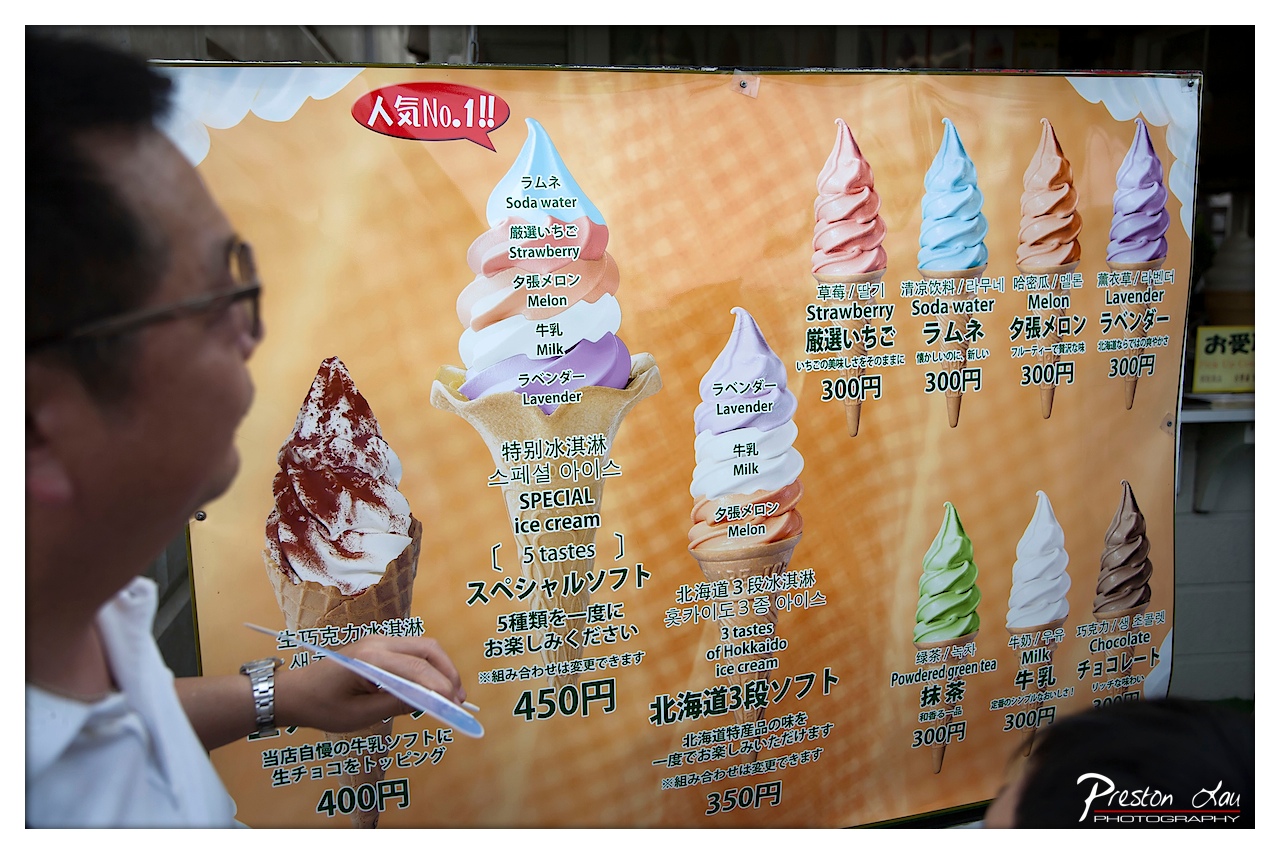

The Paradox of Choice: Ice Cream Edition
Subject Rating: 9/10
Ah, the eternal struggle! This shot perfectly captures the delightful agony of standing before a wall of frozen temptations. Our protagonist, seen intensely focused on the left, is clearly locked in a high-stakes negotiation with their taste buds, stylus in hand as if about to sign a peace treaty with their craving. The menu board itself is a vibrant landscape of soft-serve dreams, showcasing everything from classic milk and chocolate to exotic lavender and "Soda water" (a concept that sounds equally intriguing and terrifying). The sheer number of options, including a towering 5-taste "Special Ice Cream" at 450円 and a 3-taste Hokkaido special for 350円, is enough to make anyone's head spin, lending a humorous air of overwhelming possibility to the scene.
From a photographer's standpoint, this image successfully uses the large, colourful menu board as the central subject, drawing the eye across the array of sculpted soft-serve peaks. The inclusion of the person on the left provides context and a sense of scale, transforming a simple product shot into a relatable moment of customer interaction. The lighting is even and bright, crucial for making the various ice cream colors pop and ensuring all the text and images on the board are legible. Compositionally, placing the person on the edge of the frame directs attention towards the menu while also adding a human element to the otherwise static display. It’s a candid, almost documentary style that captures a small slice of everyday life, proving that even deciding on dessert can be a moment worthy of reflection (and a great photo op).
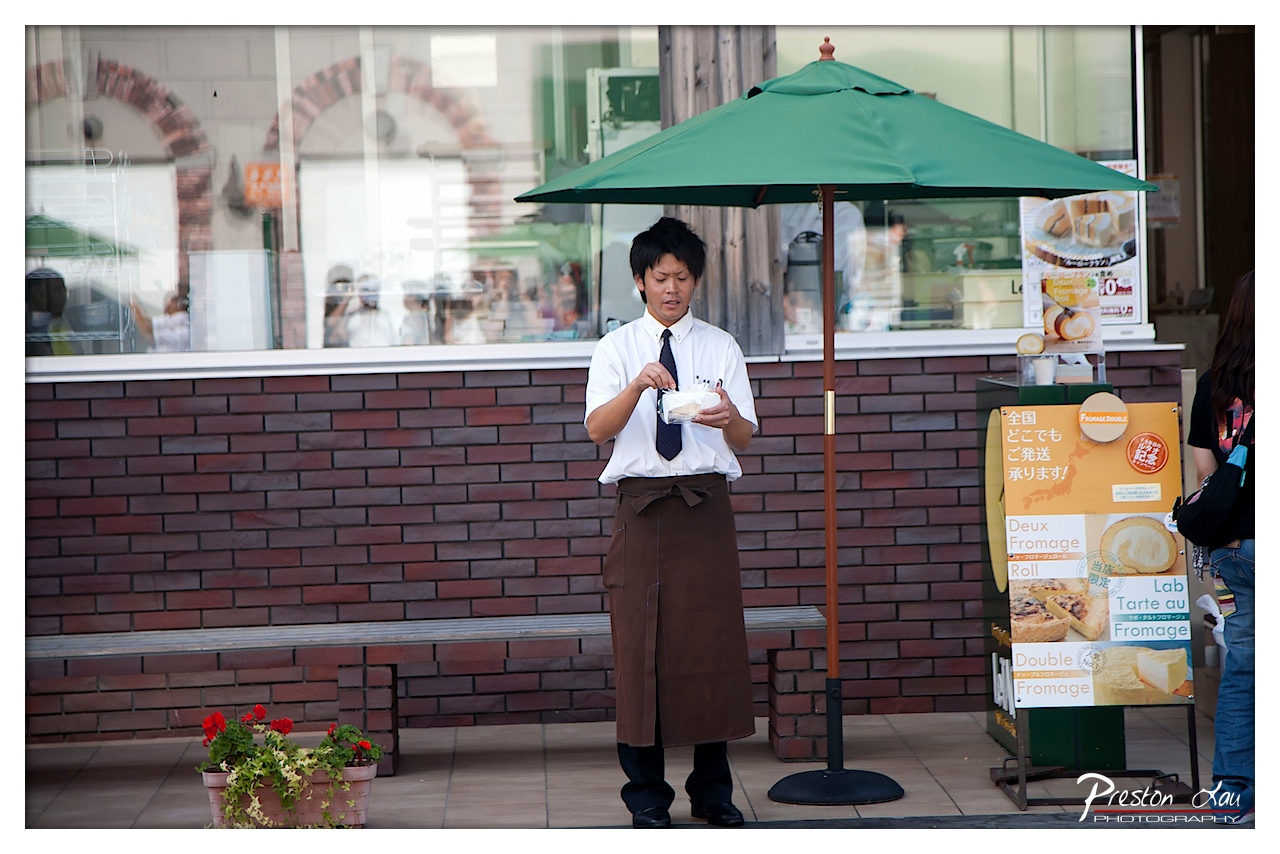

Contemplating the Tiny Box
Subject Rating: 8/10
Here we have a truly gripping scene unfolding outside what appears to be a Japanese bakery specializing in cheesy delights. Our protagonist, a dedicated employee sporting a crisp white shirt, dark tie, and a utilitarian brown apron, is engaged in a profound staring contest with a small, white container. His expression is a masterpiece of focused intensity – is he about to open the most delicate condiment packet known to man? Is he deciphering ancient glyphs etched onto the plastic? The mystery is palpable, lending a slightly awkward but intriguing mood to the image. Meanwhile, customers blur past inside the shop window, completely unaware of the epic struggle happening right outside under the benevolent shade of a large green umbrella.
From a photography perspective, this shot does a decent job of isolating the subject using a shallow depth of field, blurring the potentially distracting background of the shop interior reflections and activity. The composition places the man off-center, counterbalanced by the umbrella stand and the tantalizingly advertised cheesy goods on the sign board to the right. The earthy tones of the brick wall and apron are pleasant, with a small splash of red from the flowers in the foreground adding a touch of life. The natural light seems soft and even, likely diffused by the umbrella or an overcast sky, which works well to avoid harsh shadows on the subject. While not a groundbreaking composition, it effectively captures a small, curious moment in time, leaning into a slightly documentary style of observation.
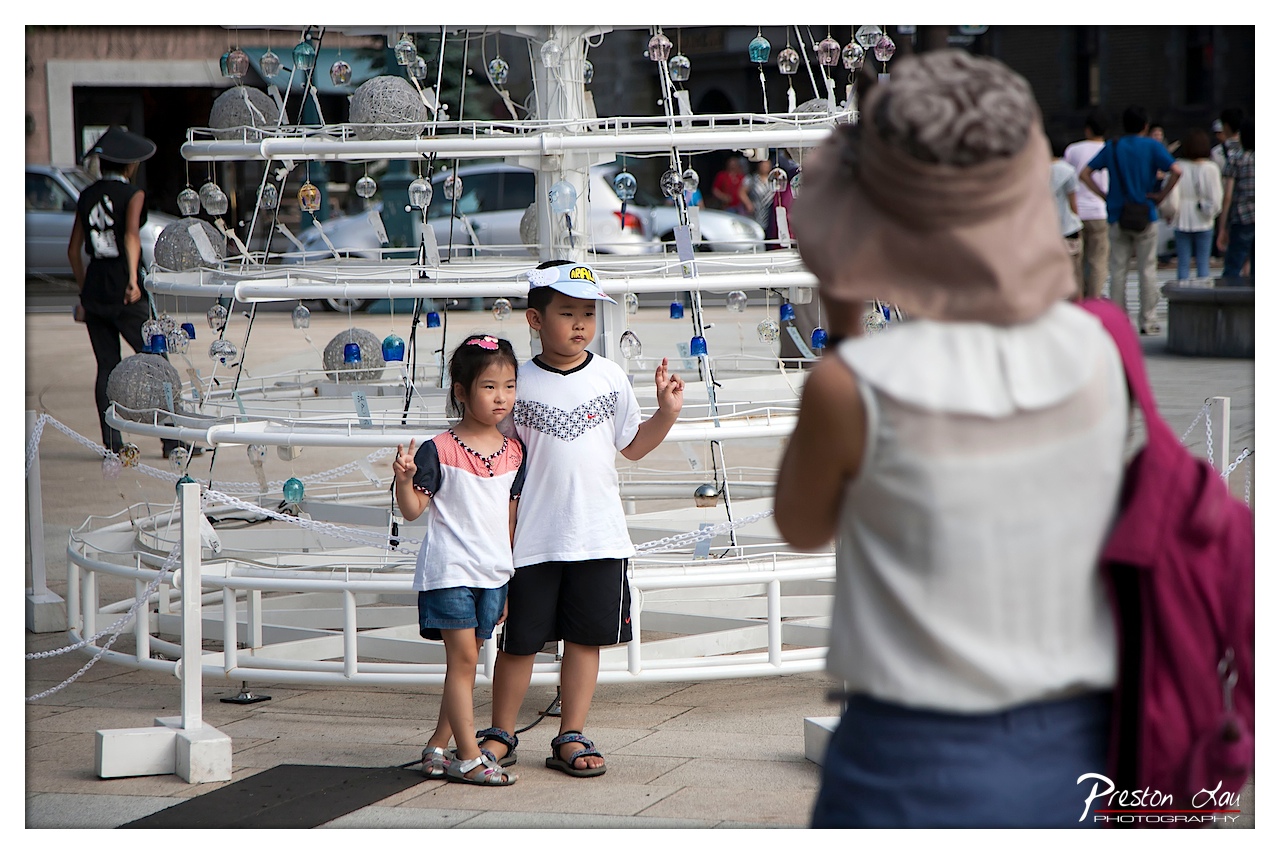

A Photo of a Photo Being Taken
Rating: 7/10
In this classic meta-moment, we observe a woman in the foreground, strategically positioned and armed with what appears to be a camera, capturing a snapshot of two young children striking poses in front of a rather intricate white, multi-tiered structure. The children, clearly the stars of their private performance, are holding up 'peace' signs with varying degrees of enthusiasm, perhaps having been coached just moments before the shutter clicked. The mood is one of a typical family outing, slightly posed but ultimately sweet, a captured memory of a moment amidst a public space. The composition is layered, with the photographer herself adding depth and context, albeit slightly obscuring the full scene, a common occurrence when trying to document the process of documentation.
Behind the young posers, the white structure is adorned with an array of dangling transparent and colored glass or plastic spheres and wind chimes, adding a busy, decorative element that serves as a festive backdrop. The lighting is the somewhat harsh, direct sunlight of a sunny day, creating strong shadows that anchor the subjects to the ground and add contrast to the scene. The background reveals a public square or street, with blurred figures of other passersby, parked cars, and buildings hinting at a bustling environment. While the backdrop is a bit cluttered, the focus remains squarely on the children and the implied interaction with the photographer. It's a charming, relatable scene, capturing the universal desire to freeze a fleeting moment, even if the result is a photo of someone taking a photo!
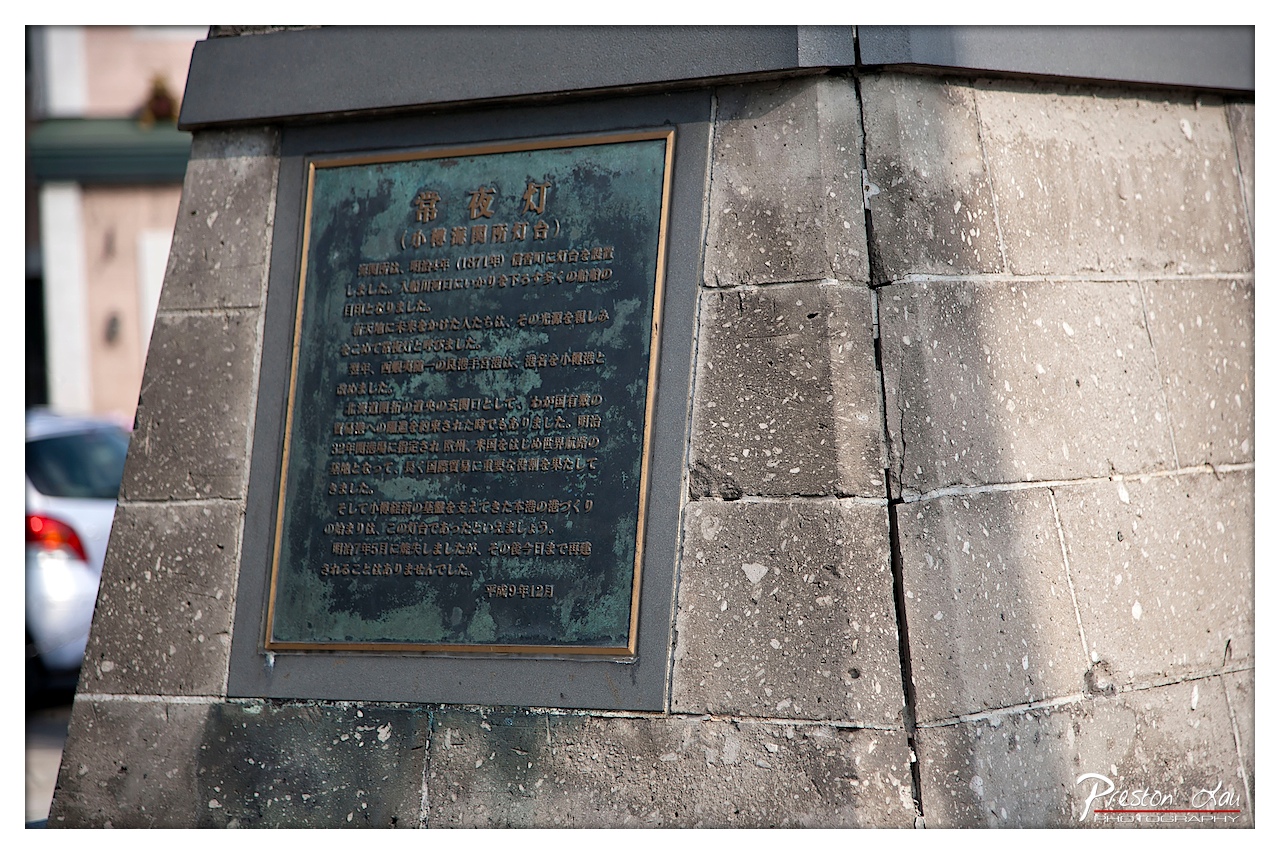

Stone Tablet in Sunlight
Subject Rating: 6/10
This frame captures a stoic stone base featuring a weathered bronze plaque adorned with enigmatic Japanese script. As a subject, a historical marker isn't exactly going to win any beauty contests, but its purpose holds significant weight, granting it a modest score. The composition places the plaque relatively central, framed by the rough-hewn stone blocks which dominate the foreground and mid-ground. The use of a shallow depth of field effectively blurs the background, providing just enough context of an urban setting – a hint of a white car and a warm-toned building wall – without distracting from the main event. It's a classic documentary approach, isolating the subject against its environment.
However, the lighting presents a challenge here. The harsh, direct sunlight creates strong, unforgiving shadows that carve deep lines into the stone and, unfortunately, cast a shadow right across the top portion of the plaque, making the text partially obscured – a photographer's nightmare when the whole point is the information! This high contrast also flattens some of the subtle color variations in the weathered bronze. On the plus side, the texture of both the stone and the plaque is wonderfully rendered, showcasing the passage of time. It feels like a snapshot taken on the fly, focusing on the historical artifact despite the less-than-ideal sun conditions, perhaps a testament to capturing the moment regardless of technical perfection.
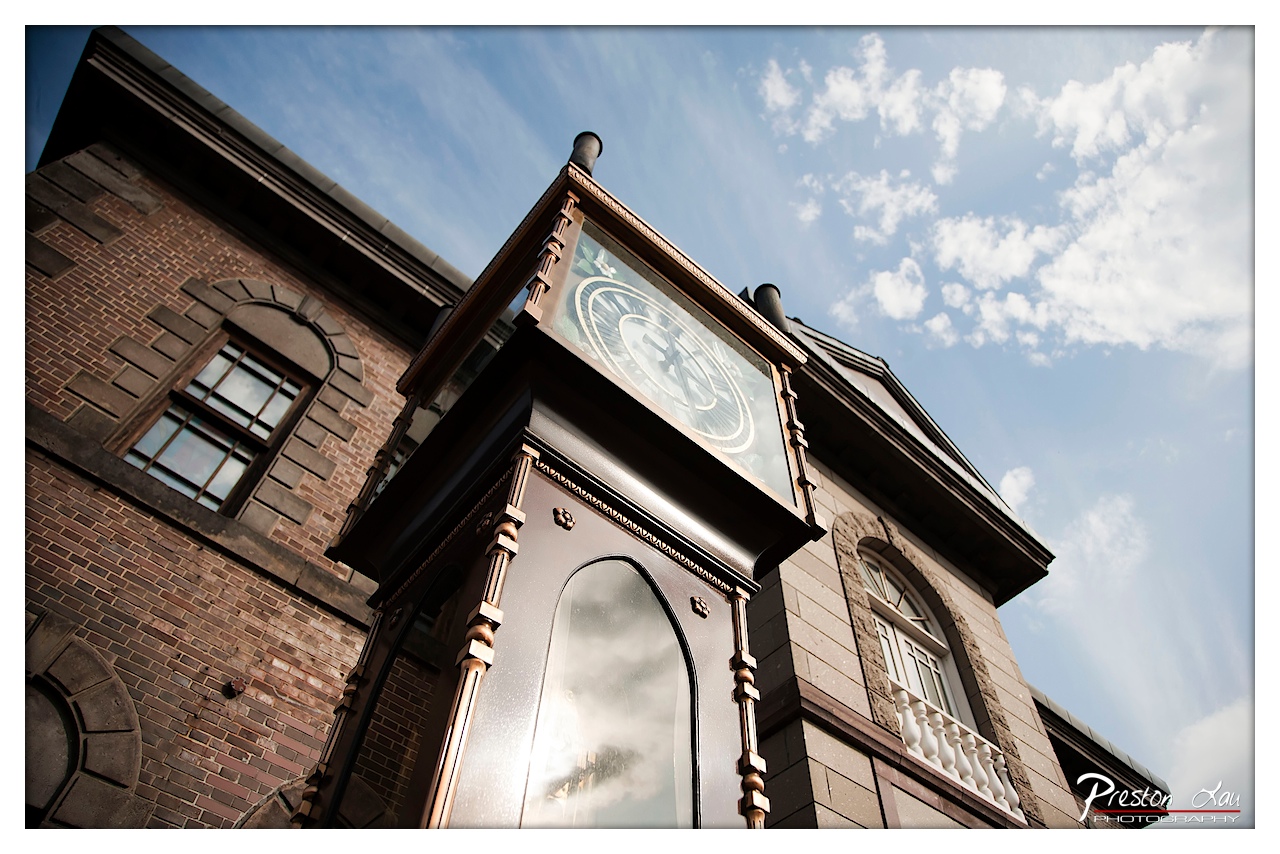

Time Lord's Perspective
Rating: 7/10
Here we have a rather imposing shot of what appears to be a grand old clock attached to a historic building, or perhaps straddling two different architectural styles if you squint hard enough – one side brick, the other stone. The low-angle perspective makes the clock loom large, giving it an almost sentient presence, like it's looking down its... hands... at us. We see details like arched and rectangular windows on the buildings, small chimneys or pipes perched atop the clock structure, and even a fancy balustrade below a window on the right. The sky is a pleasing blue scattered with fluffy white clouds, offering a bit of natural drama behind the stern architecture. It’s a static scene, captured at a moment when the light was clearly cooperating, casting strong shadows and highlights that emphasize the textures of the materials.
From a photography perspective, this shot absolutely nails the dramatic perspective using a low angle, making the clock and buildings feel monumental. The composition cleverly uses the converging lines of the buildings to frame the clock and direct the eye upwards towards the sky. The lighting is excellent – that late afternoon or early morning sun adds depth and texture, and the reflections in the glass of the clock and lower window are a nice touch, showing more of the environment (including the clouds, presumably). The color palette is rich and warm with the earthy tones of the brick and stone against the cool blue sky. The wide-angle lens enhances the distortion, adding to the dynamic feel, although one might wonder if the photographer had to lie on their back to get this shot. Humour aside, it's a solid architectural detail shot, perhaps just missing a human element or a slightly more compelling moment (like the time being something significant, though good luck telling from this angle!).
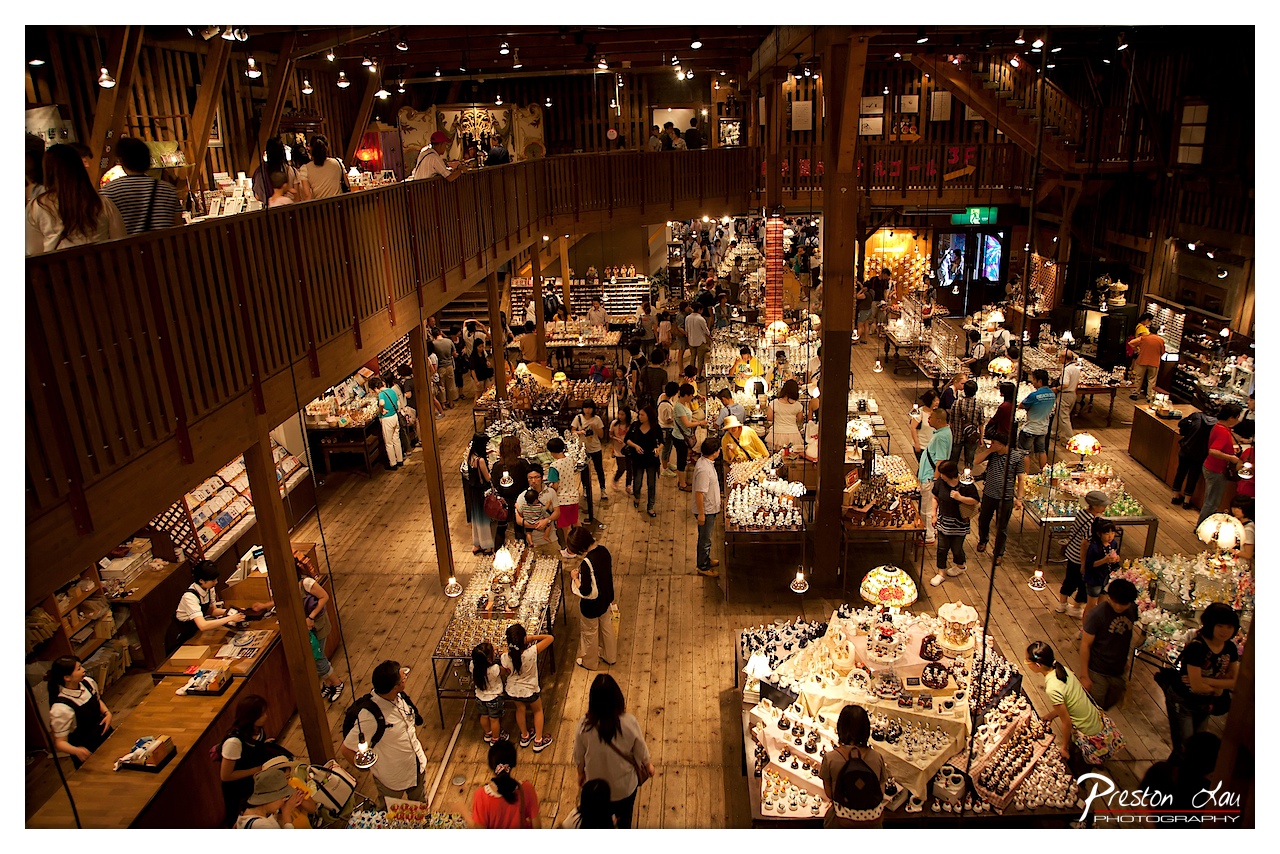

Marketplace Buzz
Subject Rating: 8/10
Step right up and gaze upon this bustling indoor marketplace, a vibrant hub of activity captured from a privileged elevated perch. The scene unfolds across multiple levels within a magnificent, warm wooden structure, reminiscent of a grand old barn or warehouse repurposed into a shopper's paradise. Below, the ground floor is a hive of motion, with people weaving between tables laden with what appears to be an astonishing array of shiny, colorful trinkets, glass figurines, and perhaps souvenirs or crafts. Up above, figures lean over a sturdy wooden railing, surveying the scene or browsing wares displayed on the second-floor balcony. The air seems thick with the energy of browsing and discovery, illuminated by a multitude of warm, inviting lights that cast a golden glow across the polished wooden floorboards and highlight the dazzling displays.
From a photographic perspective, this shot is a fantastic exercise in managing complex environments. The composition, taken from above, provides excellent depth and scale, pulling the viewer's eye across the layered scene. It's like a 'Where's Waldo' for retail enthusiasts, but the lighting is the real star here – those numerous warm lamps create a cozy atmosphere that perfectly complements the wooden interior, though balancing exposures with so many point light sources can be tricky business; hats off to keeping those highlights under control! The rich, warm color palette dominates, giving the image a welcoming, almost nostalgic feel. It’s a lively snapshot of commerce and human interaction, capturing the delightful chaos of a place where treasures are found and wallets are lightened – likely filled with more glass elephants than practical items, but who's judging?
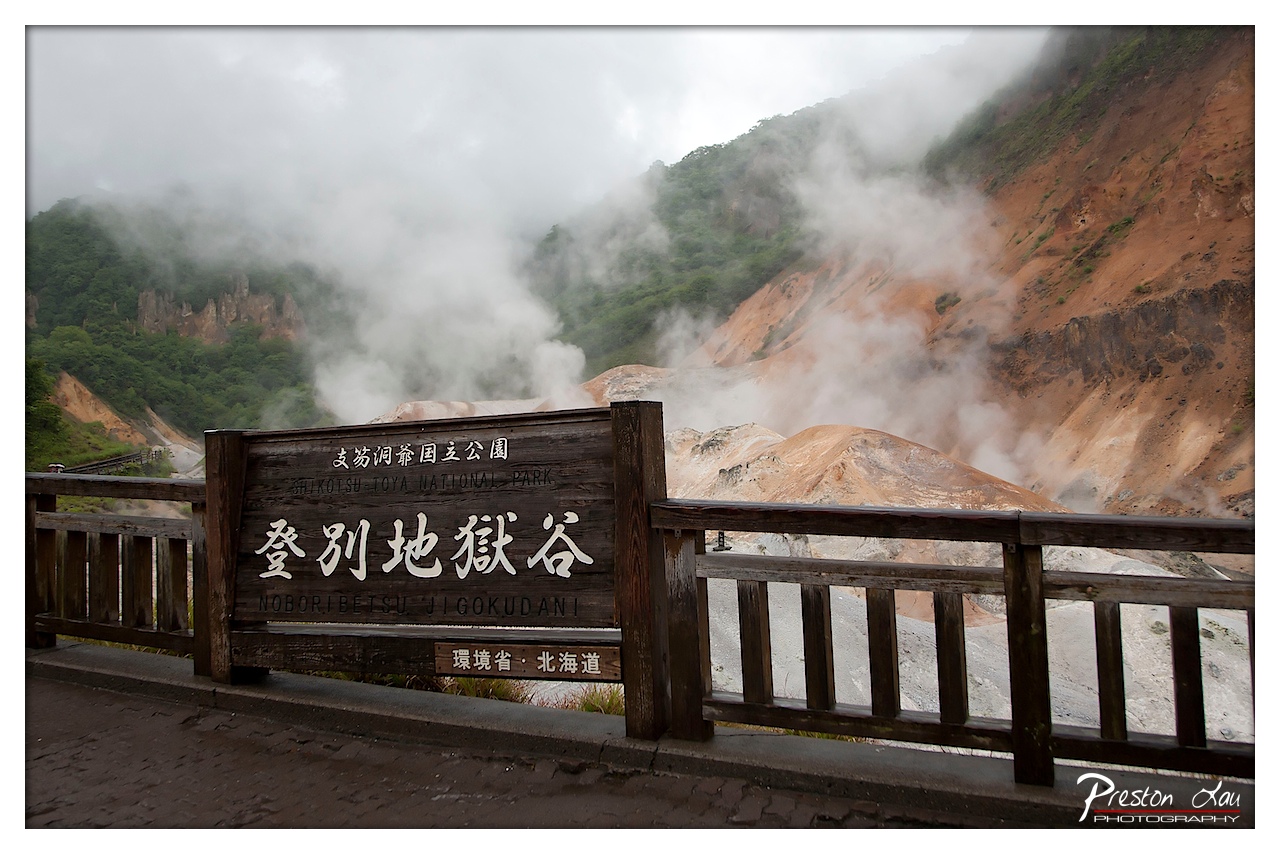

Noboribetsu's Steamy Welcome
Subject Rating: 9/10
Welcome to Hell... Valley, that is! This shot perfectly captures the otherworldly atmosphere of Noboribetsu Jigokudani in Hokkaido, Japan. The main action here is the intense geothermal activity, with thick, billowing steam rising from the volcanic landscape like nature's own dramatic smoke machine. The mood is distinctly eerie and mysterious, almost like stumbling upon the entrance to another realm – hopefully one with good onsen baths nearby. In the foreground, a prominent rustic wooden sign marks the location, complete with Japanese characters and English translations ("SHIKOTSU-TOYA NATIONAL PARK", "NOBORIBETSU JIGOKUDANI", and some environmental ministry details). A simple wooden railing acts as a barrier and a frame, resting on a wet concrete path, hinting at the damp, steamy conditions. Behind the sign and railing, the dramatic background unfolds: slopes of reddish-brown and grey earth, scarred by volcanic activity, contrast sharply with pockets of stubborn green vegetation clinging to the hillsides. The rising steam and mist obscure the upper reaches and distant peaks, adding to the valley's reputation as a perpetually steamy cauldron.
From a photographic perspective, the composition uses the sign and railing effectively to anchor the foreground and provide context before leading the eye into the dramatic, steamy landscape. It gives a sense of being right there at the edge of this fascinating geological site. The lighting, under seemingly overcast skies, is soft and diffuse, which works well to bring out the textures of the earth and the ephemeral nature of the steam without harsh shadows. The color palette is dominated by muted natural tones – the earthy oranges and reds, the dark wood of the sign, and the omnipresent white and grey of the steam against the green. Capturing the movement and volume of the steam is key to the subject matter, and this image does a decent job, though the mist does flatten the scene slightly. Shooting in such steamy conditions can be a technical challenge, requiring careful lens cleaning! Overall, it's a solid travel landscape shot that captures the essence of this unique location, signed off appropriately by Preston Lau Photography in the corner, just in case you needed reminding who got that perfect steamy snap.
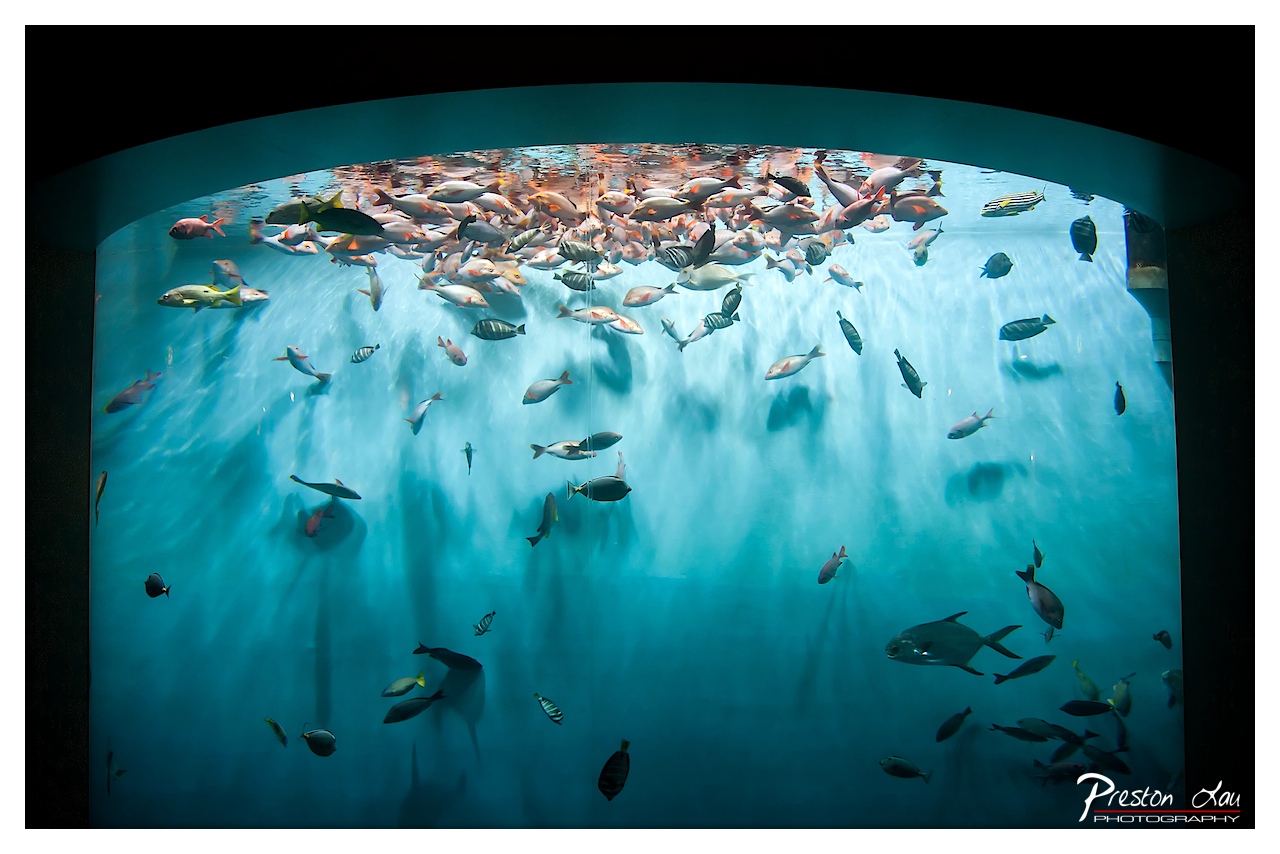

Ocean Disco: Rush Hour in the Fish Tank
Subject Rating: 9/10. Let's face it, a giant tank full of colorful, swimming fish is pretty compelling subject matter. It's like reality TV, but wetter and with fewer questionable life choices.
This image captures a bustling underwater world within a large aquarium tank. A dense school of silvery and pinkish fish congregates near the surface, mirroring the light filtering down, while larger, more solitary individuals patrol the deeper blues below. It's a vibrant scene of aquatic life in constant motion, giving off a sense of serene chaos – imagine a very crowded, very damp dance floor where everyone just keeps swimming in circles. The composition effectively uses the curved architecture of the tank opening to frame the underwater spectacle, drawing the eye into the depths while highlighting the shimmering surface activity. The sheer number and variety of fish provide a rich tapestry of form and scale, from the small striped sergeant majors to the larger, darker shapes cruising lower down.
From a photographer's perspective, this tank presents the classic aquarium challenge: navigating low light, fast-moving subjects, and often less-than-pristine glass. However, the key win here is the dramatic lighting. The rays of light piercing through the water create stunning, almost painterly patterns on the blue background, adding significant depth and visual interest beyond just the fish themselves. The cool blue and turquoise tones dominate, punctuated by the warmer oranges and pinks of the schooling fish and the occasional flashes of yellow or black stripes. Capturing sharp images of individual fish among the throng requires patience and likely a slightly higher ISO than ideal, leading to some softness on the faster movers, but the overall scene is well-exposed to capture the dynamic range from the bright surface to the murky bottom. It's a testament to finding the beauty in the chaos and working with the challenging environment to highlight its most visually striking features.
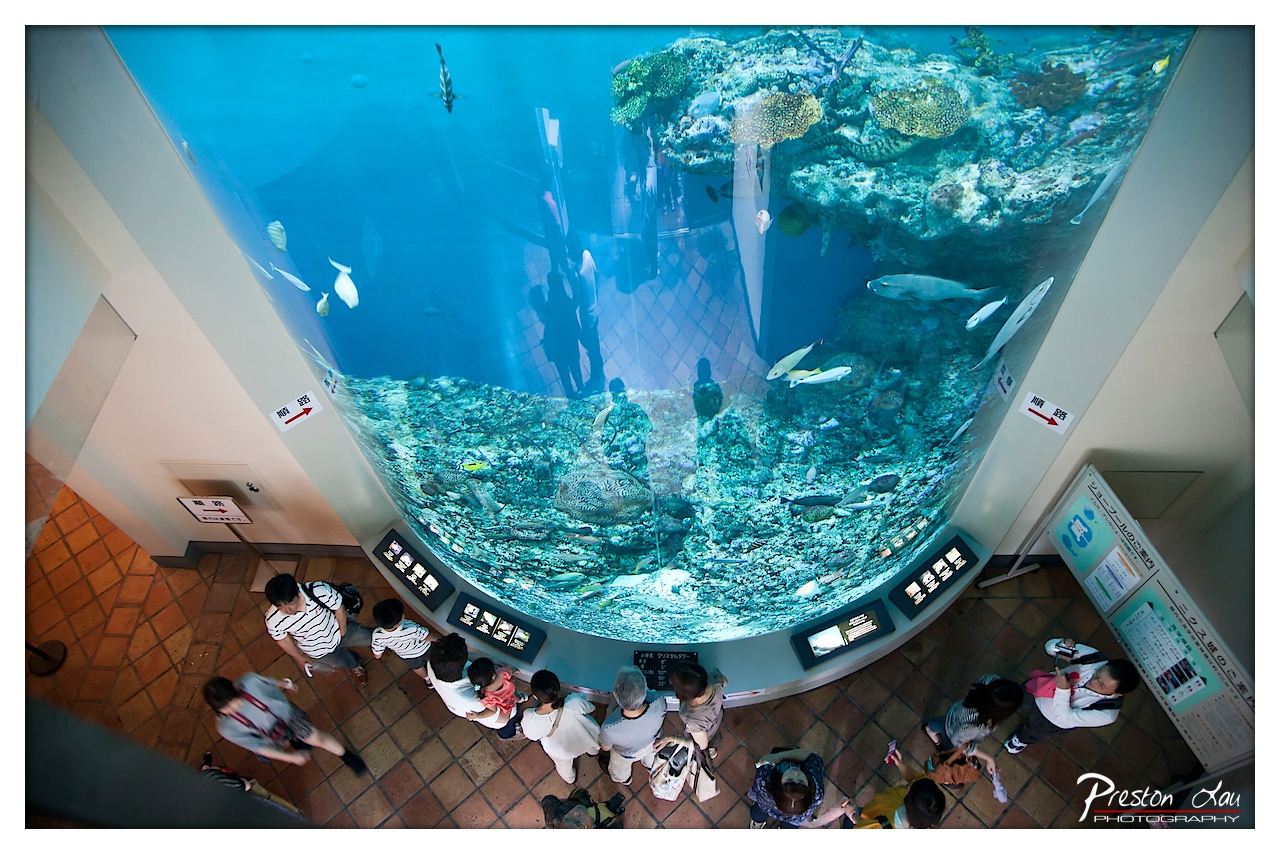

A Fish-Eye View of Fish-Gazers
Subject Rating: 9/10
This high-angle shot plunges us directly into the scene of an immersive aquarium exhibit, capturing the sheer scale of a massive cylindrical tank filled with vibrant marine life. Below, a crowd of onlookers forms a semi-circle, their heads tilted upwards, utterly captivated by the spectacle of colorful fish navigating the artificial reef structures. The bright, ethereal blue light emanating from the tank contrasts sharply with the warmer, tiled floor where the visitors stand, creating a dynamic visual separation between the underwater world and the human realm. It's a moment of shared wonder, illustrating humanity's enduring fascination with the mysteries of the deep, albeit viewed through several inches of glass.
From a photographic perspective, the high angle offers a unique, almost abstract view, turning the human observers into patterns on the floor while emphasizing the towering presence of the tank. Compositionally, the curve of the tank acts as a dominant lead-in line, though the extreme perspective does introduce some distortion, perhaps a challenge when photographing such structures. Lighting is key here, with the brilliant blues and greens of the tank illuminating the water and coral, while the surrounding area is relatively darker, creating a dramatic contrast. While the water is crystal clear, reflections on the glass add complex layers and can be tricky to manage; here, they sometimes obscure details inside the tank. The motion blur on some of the people hints at a slightly longer exposure or movement, a common challenge in dimly lit public spaces when trying to capture both the static exhibit and the moving crowd without a tripod – maybe next time, remember that stabilization or a higher ISO!
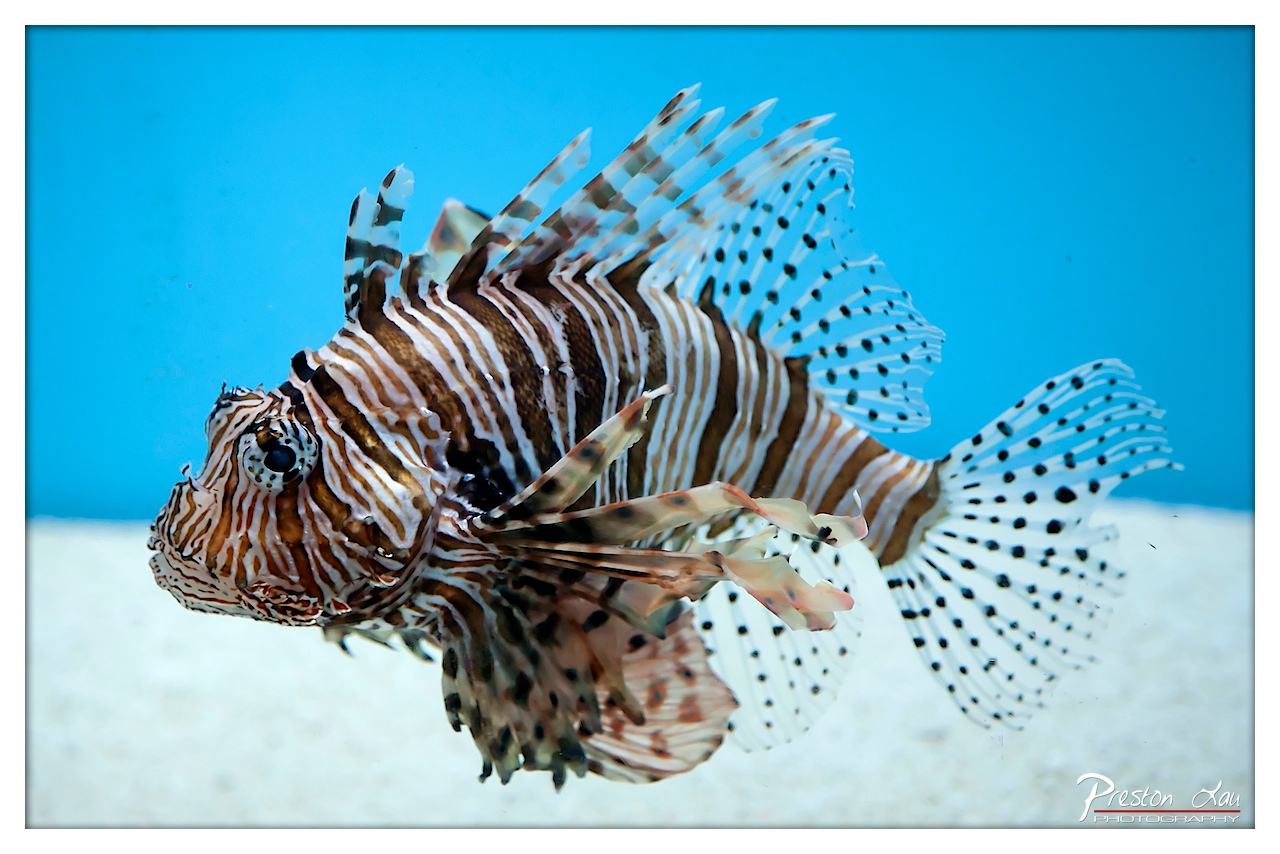

Lionfish Portrait
Subject Rating: 9.5/10
Here we have the underwater equivalent of a punk rocker wearing stripes – a magnificent lionfish, just hanging out, looking incredibly dramatic. This striking subject, with its elaborate pectoral fins spread wide like a flamenco dancer's skirt and venomous dorsal spines poised for action (or just posing), is captured mid-swim in what appears to be a well-maintained aquarium or tank. The mood is calm, almost serene, offset by the inherently dangerous appearance of the fish itself. It's like a beautiful, silent warning sign floating in the water, probably contemplating the existential dread of being behind glass all day, or maybe just wondering where the next meal is coming from. The sandy bottom provides a simple stage for our star, while the clear blue water ensures there are no messy distractions from the main event.
From a photographic standpoint, the composition is straightforward, placing the lionfish prominently in the frame, allowing its intricate patterns and structures to dominate. The lighting is excellent, highlighting the alternating bands of reddish-brown and white stripes and making the dark spots on the fins pop against the transparent fin material. The vibrant, uniform blue background offers fantastic separation and contrast for the richly detailed subject – it’s the perfect minimalist backdrop for this flamboyant character. The clarity is impressive, capturing the fine details of the scales, eye, and delicate fin rays. It's a clean, well-executed shot that focuses purely on showcasing the unique beauty (and perhaps underlying menace) of this fascinating creature. The photographer, Preston Lau, clearly knows how to make a potentially dangerous subject look absolutely stunning without getting too close.
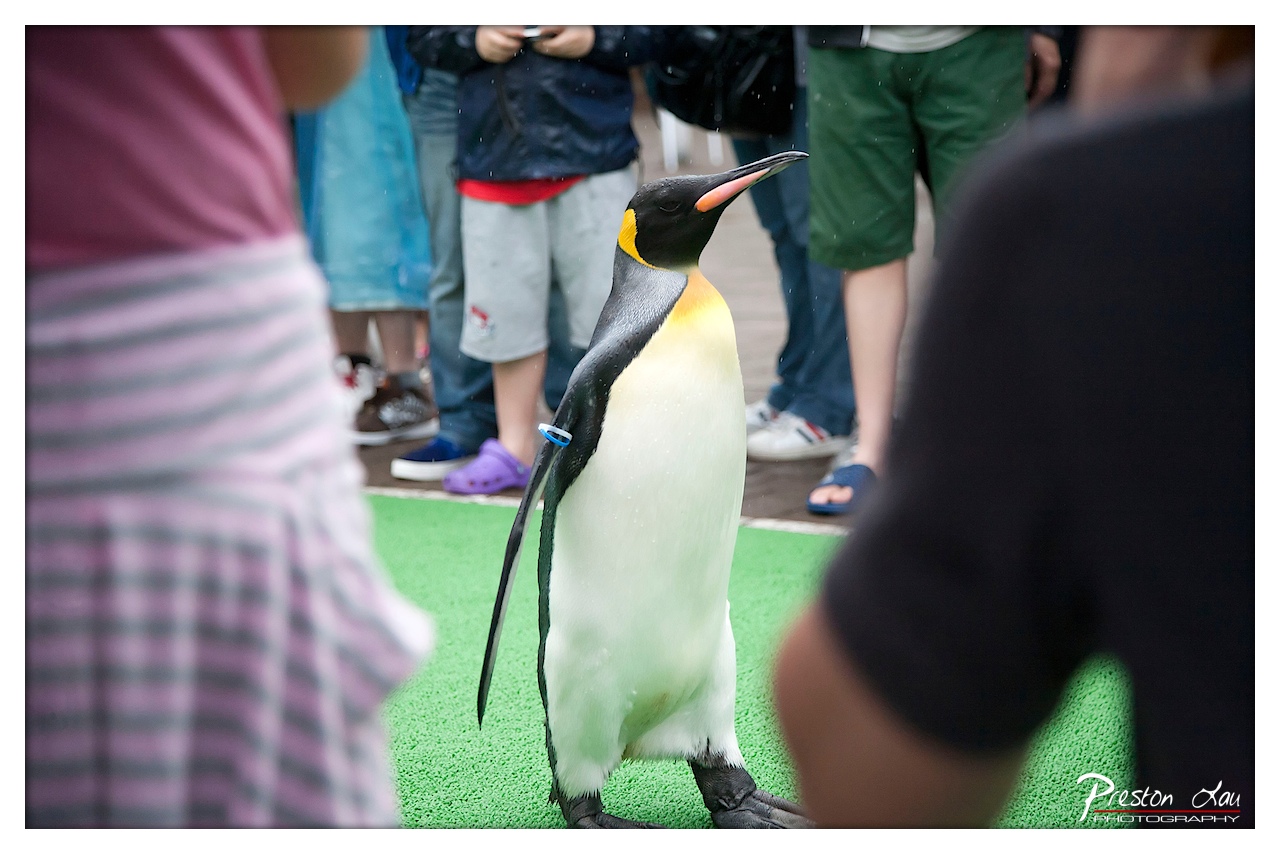

Title: The Penguin Walk of Fame (Or Shame?)
Rating: 7/10
This photo captures a truly *regal* subject, a magnificent King Penguin, strutting its stuff amidst a decidedly less majestic crowd. The penguin, easily the star of the show (a solid 9/10 for sheer charisma), is caught mid-stroll on a bright green surface, looking perhaps a touch unimpressed by the bipeds lining its path. What appears to be a penguin parade or a zoo encounter is taking place, with various onlookers clad in casual attire, ranging from summery shorts and t-shirts to more practical jackets, suggesting potentially unpredictable weather. The foreground features a heavily blurred person in a pink and grey striped dress and another person on the right, framing the central figure but also adding a significant amount of visual weight. The overall mood is slightly chaotic but also expectant, like waiting for a celebrity to walk the red carpet, only the celebrity is a bird with flippers.
From a photography perspective, the composition leans heavily on framing, using the blurry figures to guide the eye towards the sharp penguin, though the left foreground figure is quite dominant and perhaps slightly distracting. The lighting is soft and diffuse, suggesting an overcast day or a shaded area, which does a good job of evenly illuminating the penguin's striking plumage without harsh shadows. The colors pop, particularly the vibrant green ground and the penguin's distinctive yellow and orange patches, contrasting nicely with the muted tones of the crowd's clothing. The focus is squarely on the penguin, achieving a pleasant bokeh that softens the background and emphasizes the subject. While the framing is bold, one might question if the foreground blur is *too* much, competing slightly with the main act, but it certainly gives the image a sense of place and the feeling of being right there in the crowd.
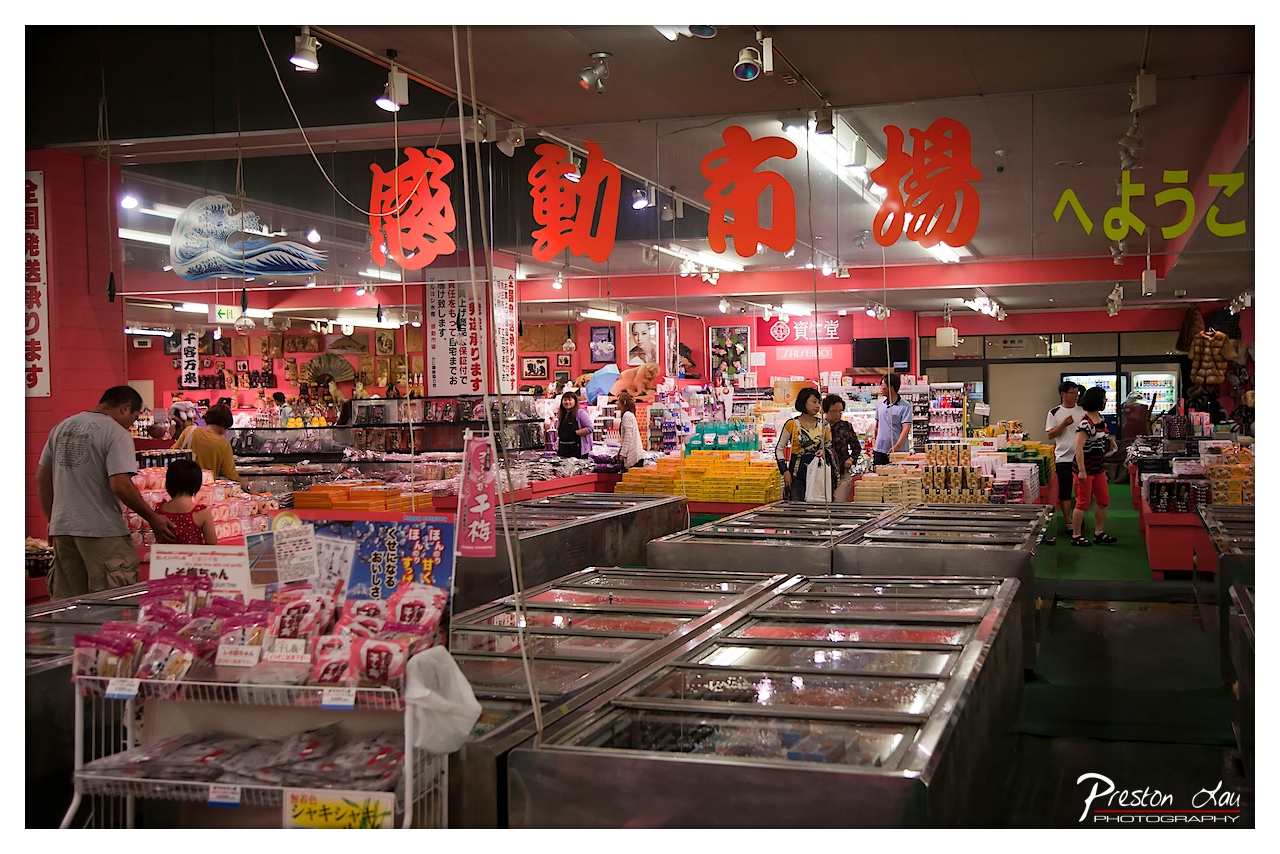

Title: Market Mayhem in Red
Rating: 7/10
Step right up, folks, and welcome to what appears to be a bustling Japanese market, likely specializing in seafood or local delicacies, given the sheer number of chest freezers on display. The rating is a solid 7/10 – it captures the chaotic energy and vibrant character of the place, even if it feels a bit like sensory overload just looking at it. The dominant blood-red walls and bright orange signage immediately assault the eyes, screaming for attention like a rogue lobster trying to escape its tank. Shoppers mill about, deep in contemplation over frozen delights or perhaps just trying to navigate the densely packed aisles without tripping over a rogue package of pickled plums.
From a photographer's perspective, this shot is a classic documentary snapshot of a real-world scene. The composition offers decent depth, leading the eye through the rows of frosty sarcophagi towards the back of the store, though the foreground feels a tad cluttered with product displays that aren't quite sharp. The lighting is typical for this kind of establishment – functional but unforgiving, creating harsh highlights and reflections, especially on the freezer lids, obscuring their potentially fascinating contents (is that frozen squid? The mystery!). The giant calligraphic characters hanging from the ceiling and the mirrored wall reflecting more signs and products layer the scene, adding to the sense of being lost in translation, but also effectively conveying the atmosphere of this lively, slightly overwhelming retail environment.
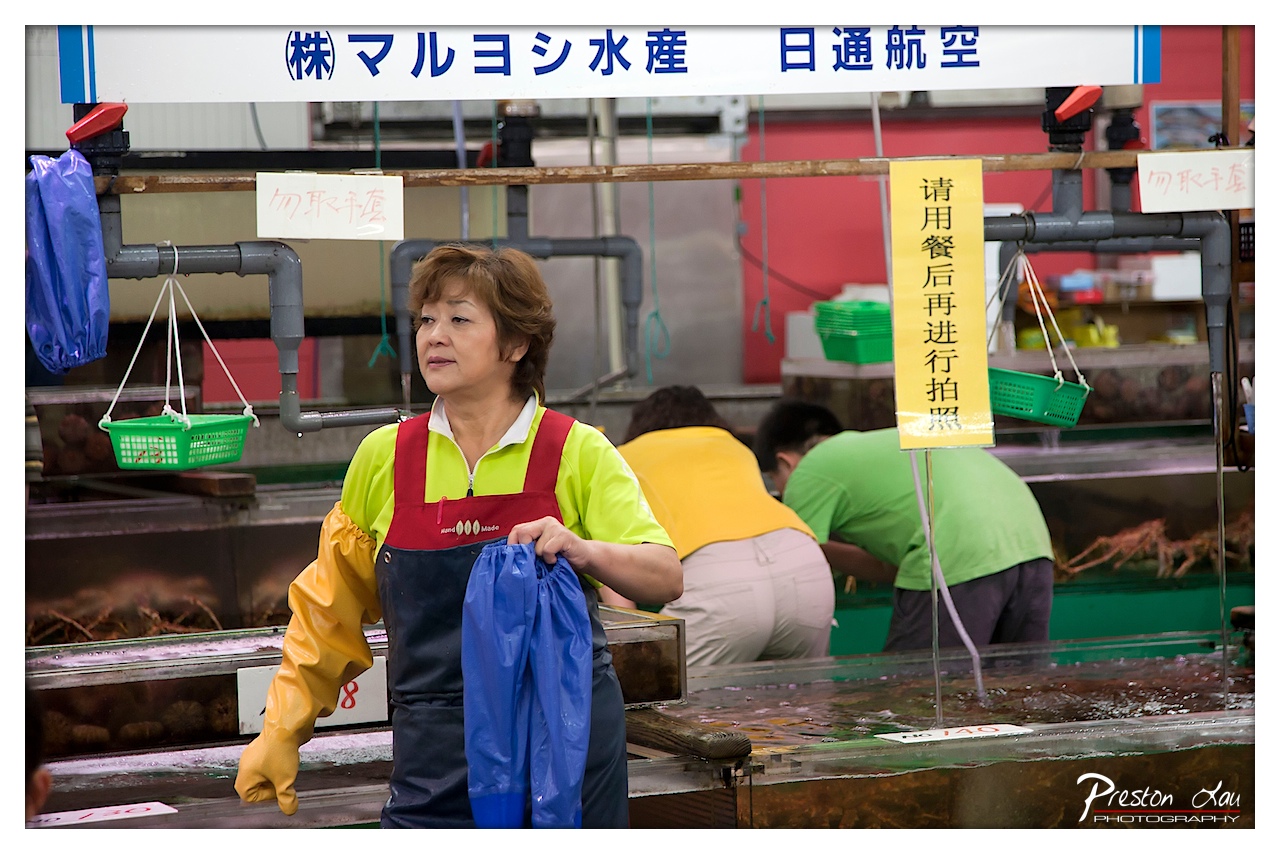

Market Empress and the Crabs
Rating: 7/10
In this vibrant, slightly chaotic market scene, our central figure stands front and center, sporting an expression that says "I've seen more crabs than you've had hot dinners, and frankly, some of them had better table manners." She's kitted out in a practical apron, a surprisingly bright chartreuse top, one massive yellow glove that looks ready for heavy-duty handshakes or perhaps just wrestling particularly feisty lobsters, and she's clutching a bright blue drawstring bag, the contents of which are a complete mystery – perhaps it's her lunch, or maybe the day's prize catch wrapped for stealthy transport. The background is a working market artist's canvas: gleaming tanks filled with lively (or perhaps soon-to-be lively) creatures, a tangle of pipes, hoses, and hanging blue covers that add pops of color, and hints of other market-goers or staff tending to their stations. There's a sense of authenticity and the everyday hustle captured here.
From a photographic standpoint, the composition places our intrepid vendor slightly off-center, allowing the background elements to provide context without completely overwhelming her. The lighting appears to be a mix of overhead fluorescents and perhaps some ambient light, resulting in a slightly harsh, mixed-temperature look that is typical of such environments, giving the scene a raw, unfiltered feel. The colors are quite saturated, with the bright greens of the baskets, the yellow of the sign (warning about taking photos *after* eating – a polite request, perhaps aimed at preventing hangry snapping?), and the subject's clothing standing out against the more subdued blues and grays of the market infrastructure. The subject matter is a compelling environmental portrait, capturing a moment of pause amidst the activity. While the background can be a bit distracting with its various pipes and tanks, it successfully grounds the subject in her world, telling the story of her workplace. It's a candid shot that feels genuine, even if the lighting isn't studio-perfect; it perfectly captures the atmosphere.
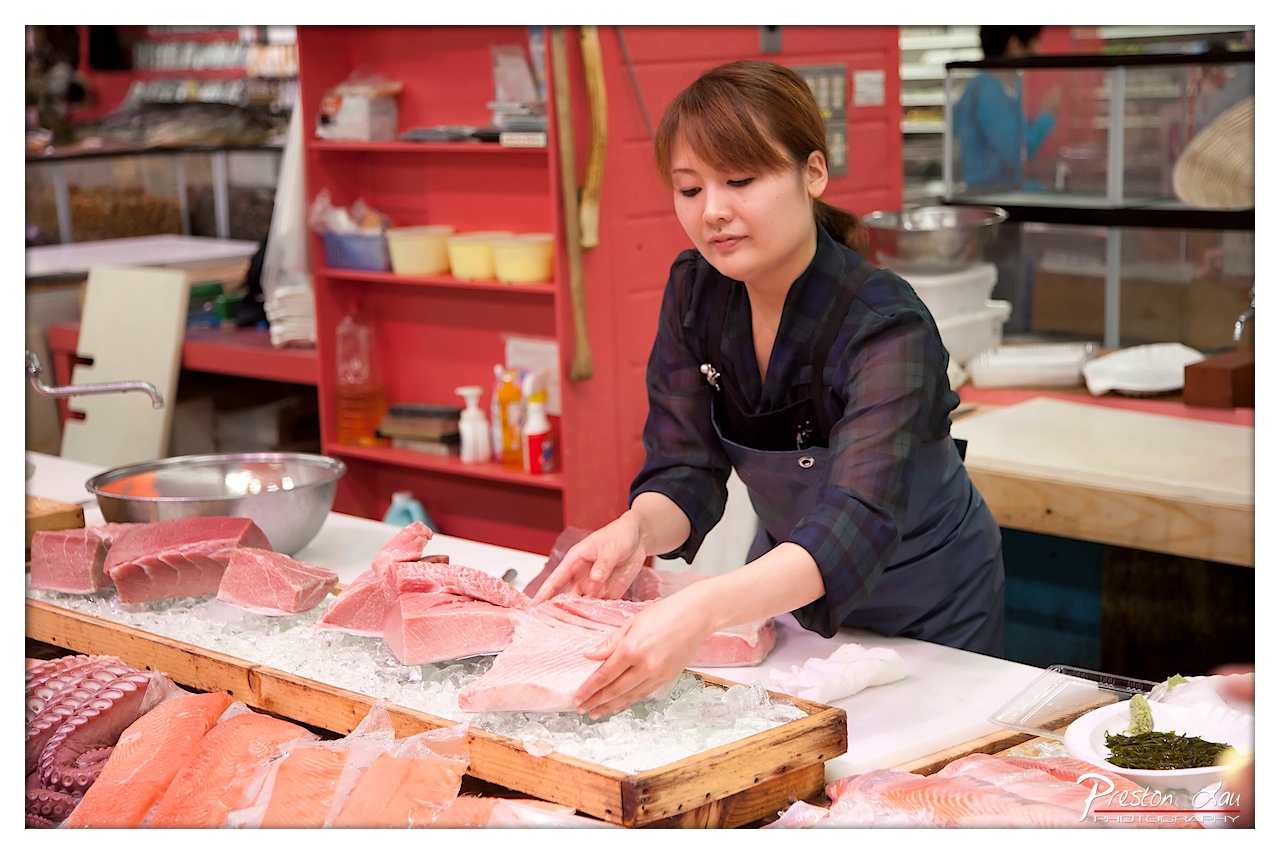

Fish Market Focus
Rating: 8/10 (for the subject's engaged intensity)
Here we witness a moment of quiet focus amidst the bustling energy of a fish market, featuring a dedicated professional meticulously handling large, glistening cuts of raw tuna. Our subject, rated an 8/10 for her captivating concentration and skilled presence, is shown carefully inspecting or arranging pieces of premium tuna on a bed of crushed ice. The mood is one of focused professionalism, highlighting the serious business of selecting and presenting the finest seafood. Surrounding her, a generous display of various fresh catches, including vibrant red tuna blocks, octopus tentacles, and vacuum-sealed salmon fillets, underscores the abundance and quality of the offerings.
From a photographic standpoint, the composition utilizes the vibrant display of fish in the foreground to create visual interest and depth, leading the eye towards the subject. The lighting effectively illuminates the rich colors and textures of the fish, making them undeniably appealing, while a shallow depth of field masterfully blurs the background, ensuring the subject and her task remain the undisputed focus. The color palette is striking, contrasting the deep reds and pinks of the fish with the cool white ice and the strong, warm red of the shelves behind her, adding context to the market environment. Relevant objects like the metal bowl, bottles on shelves, and various fish types contribute to the scene's authenticity. The overall style captures a candid moment of expertise in a lively setting, almost making you want to reach out and select a piece, or perhaps just admire the skill involved – choosing the right cut of tuna is serious business, no room for error when sashimi is on the line!
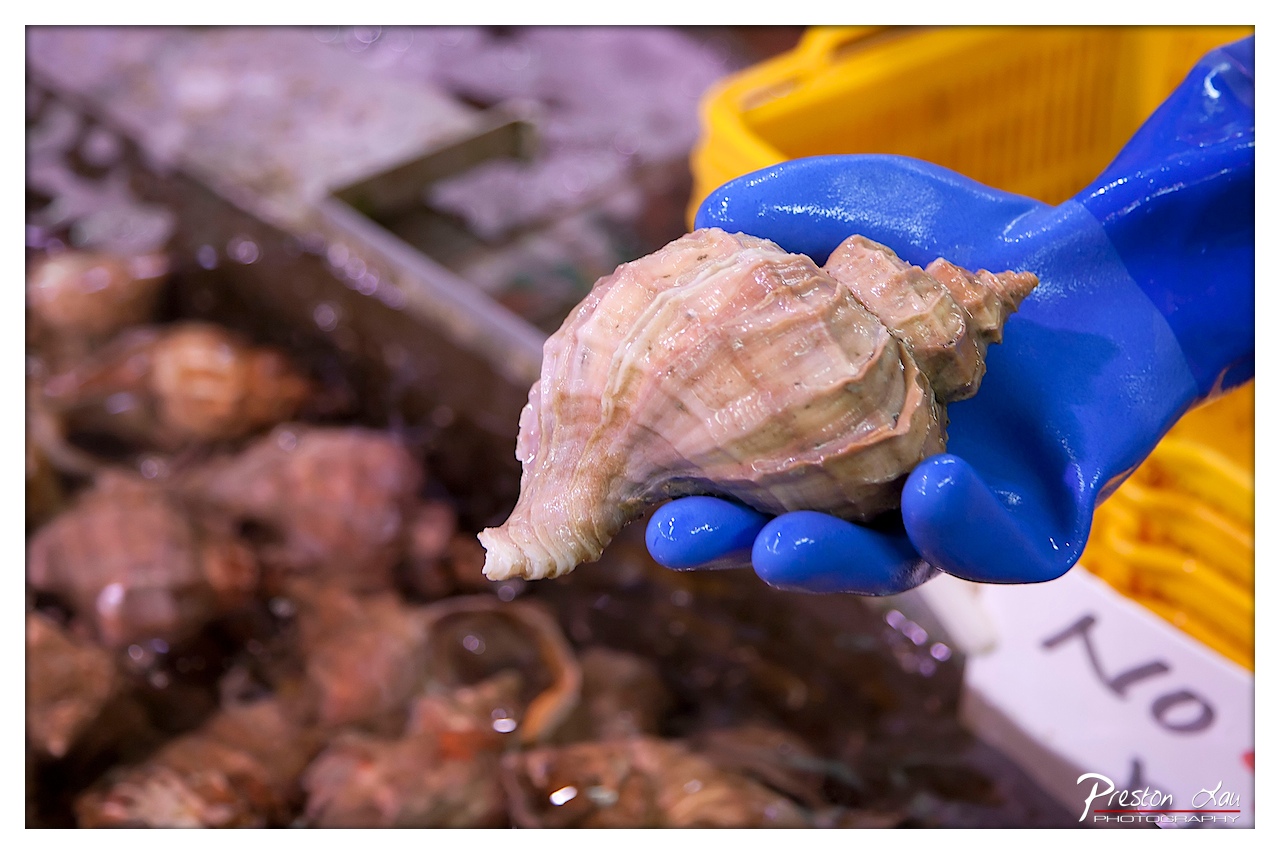

Blue Hand, Branded Whelk
Subject: 7/10
Well hello there, Mr. Whelk. This image gives us an up-close and personal encounter with a rather substantial sea snail shell, proudly presented by a hand encased in a dazzling, almost cartoonishly bright, blue glove. Forget bare hands; this is a hygienic, if slightly alien, way to appreciate marine life. The snail itself is a lovely specimen, showcasing intricate ridges and a satisfyingly spiral form in warm, earthy tones. The setting appears to be a bustling seafood market or aquaculture tank, hinted at by the blurry, watery background filled with the shadowy forms of what are likely its numerous relatives. The mood is strangely clinical yet fascinating, like a scientific display, if that display involved a superhero's handwear.
From a photographic perspective, the composition is strong, using a shallow depth of field to ensure our snail friend and its blue guardian are sharply in focus, while everything else dissolves into an Impressionistic haze. This technique effectively isolates the subject, making that vibrant blue glove leap out of the frame like a marine signal flare. Lighting seems practical, highlighting the shell's texture and adding glossy reflections to the glove. The contrast between the intense blue, the soft pinks and browns of the shell, and the muted background tones is particularly effective, creating a visually punchy image. While the background is a blur, it successfully provides context without competing for attention, allowing us to ponder the life (or recent lack thereof) of this particular mollusk, all under the watchful presence of the mysterious blue glove.
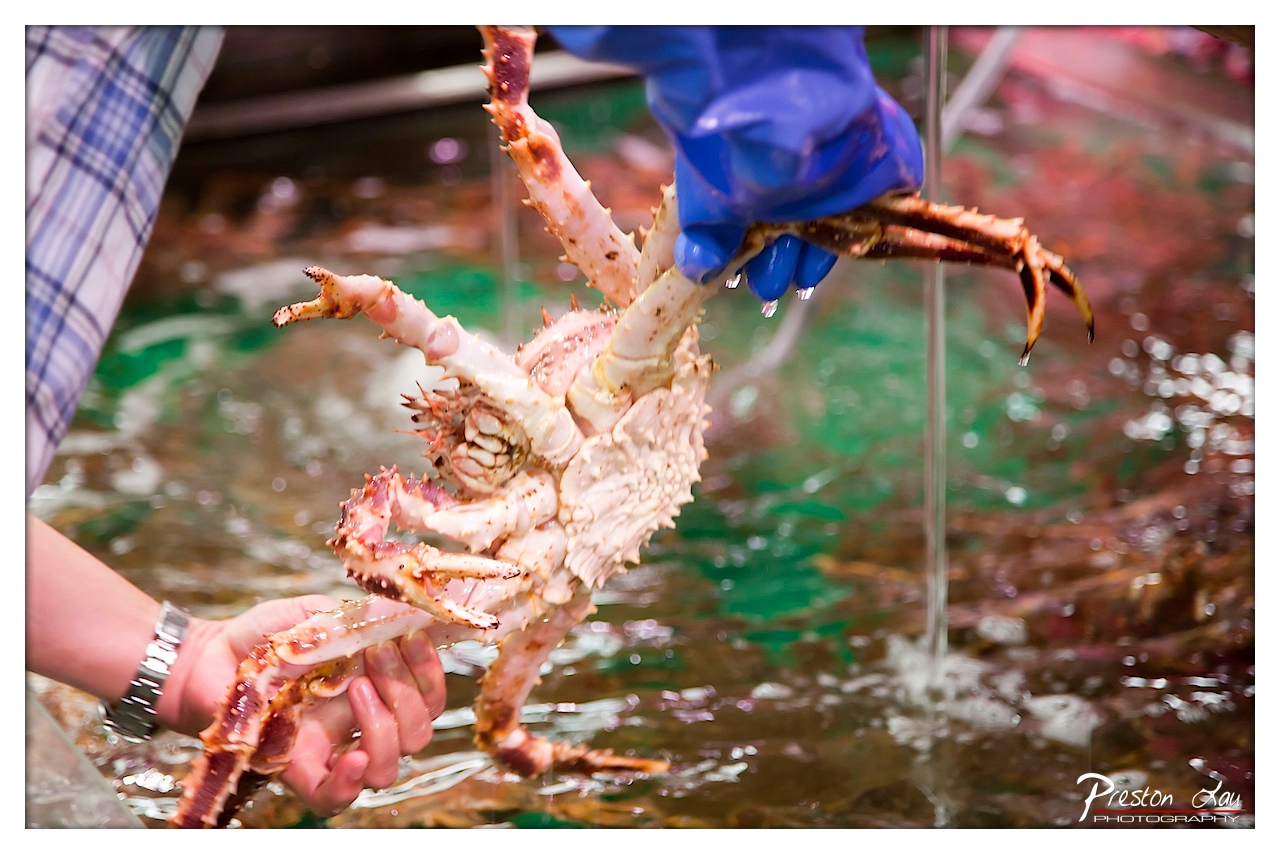

King Crab Tango
Subject Rating: 9/10
Caught mid-air in a seemingly dramatic exit from its aquatic abode, this magnificent King Crab is the undisputed star, looking every bit the spiky monarch it is. Held aloft by a peculiar pair – one hand clad in a professional-looking blue glove, the other bare and firmly grasping its numerous legs – the crab appears to be participating in a rather awkward, multi-limbed ballet. The scene unfolds over a blurry water tank, hinting at a bustling market or restaurant setting where such impressive specimens are put on display before their final curtain call. Water droplets add a dynamic touch, dripping from the crab and the gloved hand, enhancing the sense of movement and freshness. The mood is a curious mix of anticipation and perhaps a touch of performance art, as the crab is showcased to potential admirers (or diners). The foreground features the plaid shirt of one handler and the glint of a watch on their wrist, grounding the surreal sight in a human context.
From a photographic standpoint, the image masterfully employs a shallow depth of field, ensuring the colossal crustacean pops sharply against the softly blurred background of murky tank water, rendered in intriguing greens and browns. The composition is centred around the crab's body and legs, drawing the eye directly to its intricate shell texture and formidable size. Lighting is well-managed, creating highlights on the wet surfaces and the crab's exoskeleton, adding dimensionality and tactile appeal. It feels like a moment captured in time, a slice of life from a seafood market with a flair for the theatrical. The use of colour is subtle but effective, with the bright blue glove providing a striking contrast to the crab's reddish-white hues and the muted tones of the background. It's a compelling documentary shot, beautifully capturing the essence of the subject and the lively environment, making even a simple transaction look like a dramatic event.
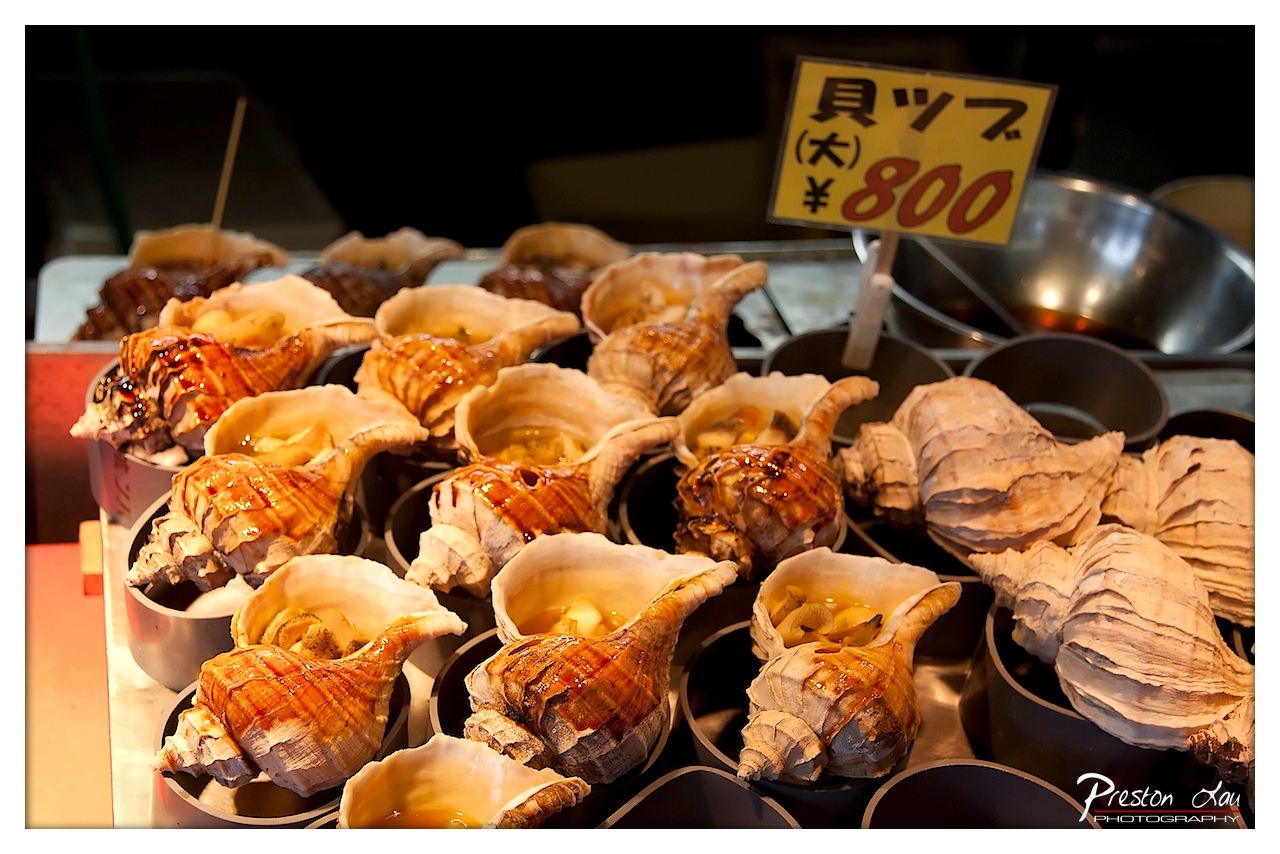

Turbo Shells on Display: The Spiky Appetizers
Subject Rating: 7/10
This photo plunges us headfirst into a vibrant market scene, presenting a tempting array of grilled turbo shells, known as *sazae* in Japan, looking like delicious sea creatures ready for consumption. What's happening is a close-up view of these peculiar snacks lined up in individual metal pots, some glistening with a dark, savory sauce and filled with their cooked innards. The mood is one of bustling market authenticity, where the focus is squarely on the food being sold. The subjects themselves are fascinatingly textured and shaped, some appearing freshly grilled with a rich glaze, while others show the raw, craggy texture of the shell itself, possibly awaiting their turn on the heat. A prominent yellow sign in the background proudly displays the price: ¥800, identifying the item as "貝 ツブ (大)" - roughly meaning "Shell Tsubu (Large)". The background is a typical market blur, hinting at other stalls and activities, adding context without distracting from the main event. A photographer's watermark is subtly placed in the bottom right corner, grounding the image in its origin.
From a photographic perspective, the composition is a tight close-up, using the repetitive forms of the shells in their pots to create visual rhythm across the frame. The shallow depth of field effectively isolates the front row of shells, drawing the viewer's eye directly to their texture and the tempting gloss of the sauce. Lighting appears to be a mix of overhead market lights, casting highlights that emphasize the moisture on the cooked shells but also creating some distinct shadows, giving the shells a slightly dramatic, almost alien appearance. The color palette is dominated by warm, earthy tones – the rich browns and oranges of the shells and glaze contrasting with the cool grey of the metal pots. This creates a visually appealing presentation of the food. The style is classic market food photography – getting close to the subject to capture its details and appeal, despite the potentially chaotic environment. It successfully highlights the unique form and apparent deliciousness of the turbo shells, making you almost want to grab one... or perhaps cautiously poke it first.
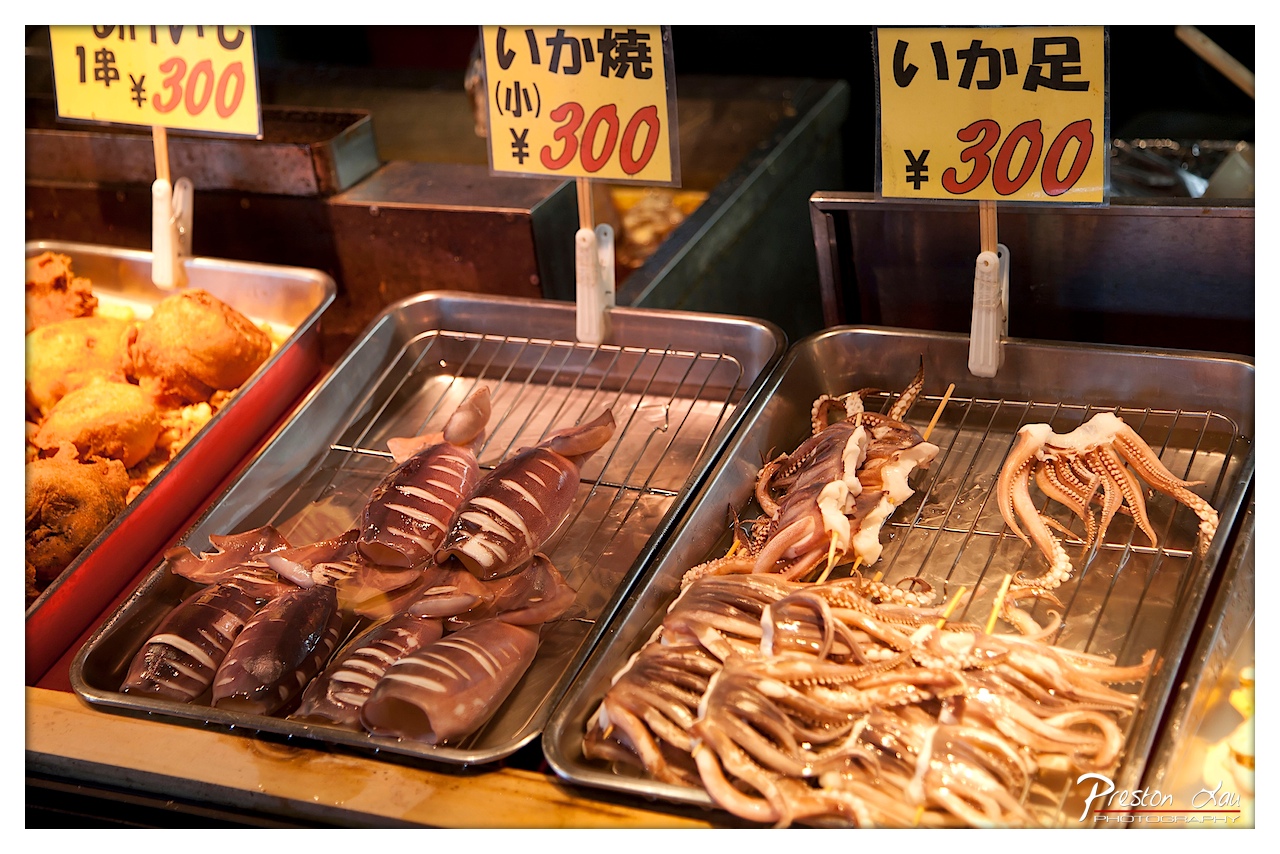

Street Food Symphony
Rating: 7/10
Ah, the glorious chaos of a street food stall! This photo drops us right into the scene, presenting a delectable (or perhaps terrifying, depending on your preferences) array of Japanese snacks. Front and center are trays absolutely loaded with skewered squid – whole small ones in the middle tray, looking remarkably intact, and a pile of just the legs on the right, a tangled mass of tentacles promising chewy goodness. On the left, a tray holds large, golden-brown fried items, perhaps some kind of fish or meat fritter, offering a textural contrast to the marine bounty. Hovering above are bright yellow signs proudly declaring the offerings and their price: ¥300 each. The signs, likely translating to something like "Grilled Squid (Small)" and "Squid Legs," are essential to the scene, providing context and tempting potential customers with affordability. The mood is one of abundance and casual street-side commerce, hinting at the lively atmosphere of a market or festival.
From a photography perspective, the composition is a no-nonsense, direct approach – filling the frame with the food and its price tags. It works effectively to show the sheer quantity available and makes the subject immediately clear. The lighting appears to be from above or the front, casting highlights on the moist squid and the metal trays. While not the most flattering studio light, it's perfectly functional for a food stall, making the items visible and highlighting their textures (glossy squid, crispy fried food). The warm color palette, dominated by browns, reds (from the tray liner), and the bright yellow signs, contributes to the inviting feel. The dark, out-of-focus background smartly pushes the food forward, ensuring there are no distractions from the main event: deciding which ¥300 snack is going to fuel your next adventure. It's a classic street food shot, capturing the essence without needing complex setups – just point, shoot, and try not to drool on the lens.
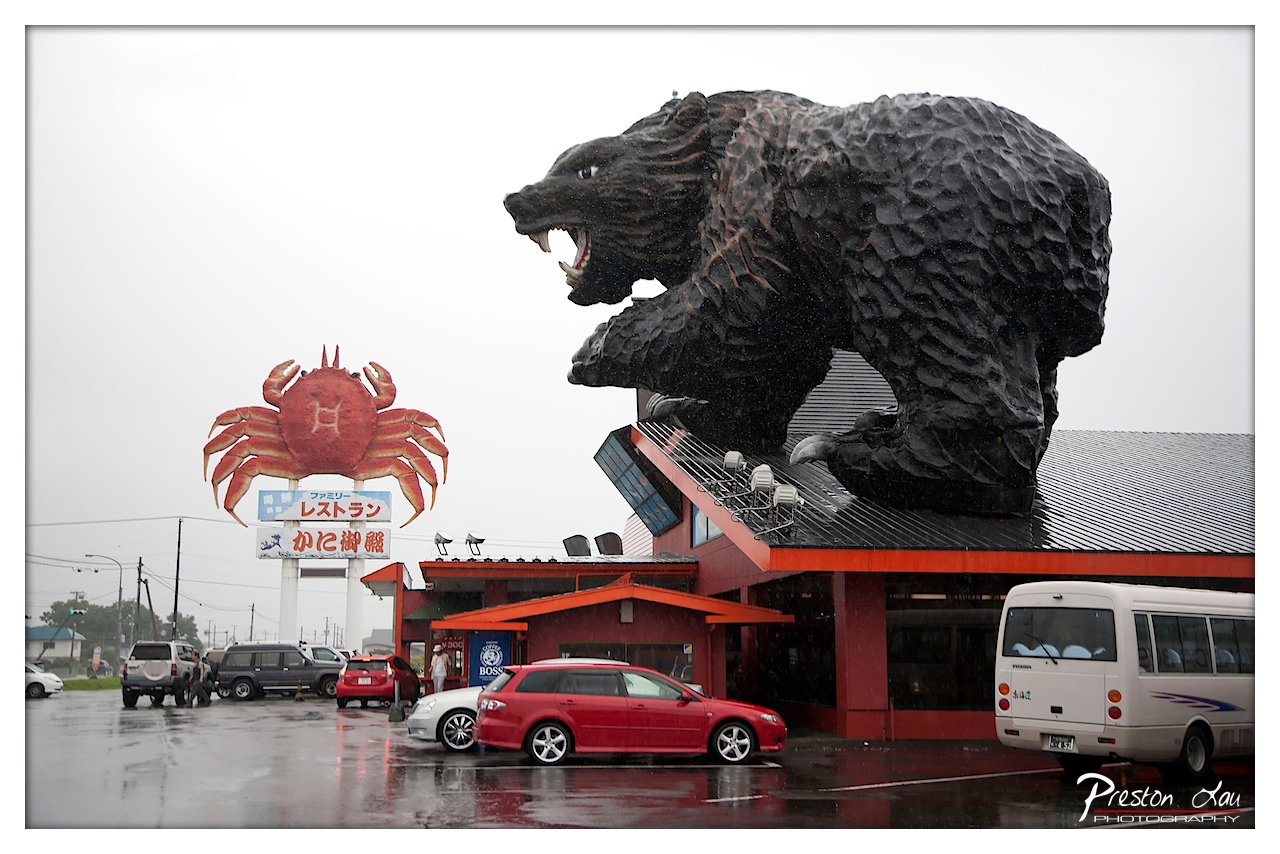

Clash of the Titans (of Roadside Kitsch)
Subject Rating: 9/10
Welcome to a scene that looks like it was dreamt up during a fever spike after eating questionable seafood – a giant, menacing black bear lunges across the roof of a building while a colossal red crab sign stands proudly nearby, perhaps advertising its next meal. It's a rainy day, adding a slightly moody, cinematic quality to this utterly bizarre tableau, with glistening asphalt reflecting the grey sky and the vibrant reds of the building and the unfortunate crustacean. Cars, including a distinct red wagon and a white van, are parked in the lot, seemingly oblivious to the looming, toothy threat above or the cheerful, oversized crab. Two figures near the entrance add a touch of human scale to the monstrous decorations, highlighting just how disproportionate these mascots truly are. Power lines crisscross the sky, and distant buildings fade into the misty background, anchoring this surreal roadside attraction in the mundane reality of a damp afternoon.
From a photographic perspective, the composition is a bold statement, pitting the dynamic, dark mass of the bear against the static, bright red form of the crab. The low horizon line exaggerates the scale of the subjects against the vast, featureless sky, which, while providing flat, even light ideal for detail, does little for dramatic effect – unless you count the inherent drama of a rooftop bear. The rain provides lovely specular highlights on the wet surfaces and adds texture to the scene, visible particularly on the bear's shaggy form. Color-wise, the limited palette of reds, greys, and blacks is punctuated by the bright crab, creating distinct focal points. The photographer has captured the sheer strangeness of the location effectively, making the most of the overcast conditions to present the scene clearly, even if the lighting lacks punch. It's a well-executed shot of an unforgettable, slightly terrifying, roadside marvel.
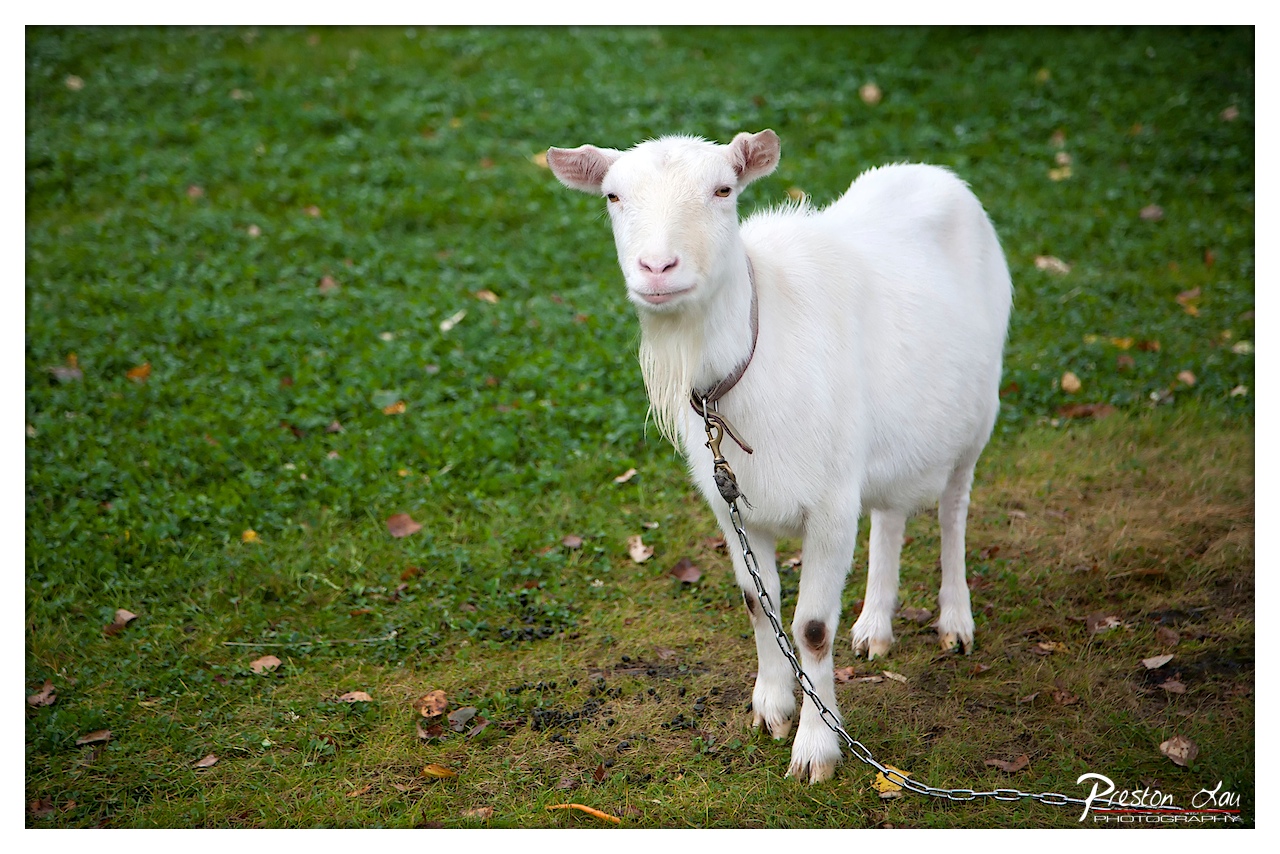

The Chain Reaction
Subject Rating: 9/10 (Excellent model, held the pose perfectly)
This portrait features a remarkably composed white goat standing its ground in a verdant grassy field littered with autumn leaves. Our subject, adorned with a simple brown collar and a sturdy metal chain tethering it to its location, gazes directly at the camera with an expression that's equal parts curious and perhaps slightly unimpressed by the photographer's antics. The long, wispy goatee adds a touch of mature dignity, contrasting slightly with the slightly askew ears. The overall mood is peaceful and grounded, despite the visible restraint, suggesting a quiet moment in the life of this domestic animal.
From a photographic standpoint, the composition places the goat just right of center, utilizing the rule of thirds effectively and leaving space on the left to balance the weight of the subject and the chain extending to the bottom right. The soft, diffused lighting, likely from an overcast sky, is absolutely ideal for rendering the details of the goat's white fur without harsh shadows, giving it a lovely texture and glow. The shallow depth of field melts the background into a pleasing bokeh of green and brown, ensuring the goat pops crisply against the setting. The color palette is simple and natural, focusing on the white of the goat and the greens and browns of the field, creating a harmonious and visually calming image. It's a well-executed animal portrait that manages to capture personality despite the subject's limited range of movement.
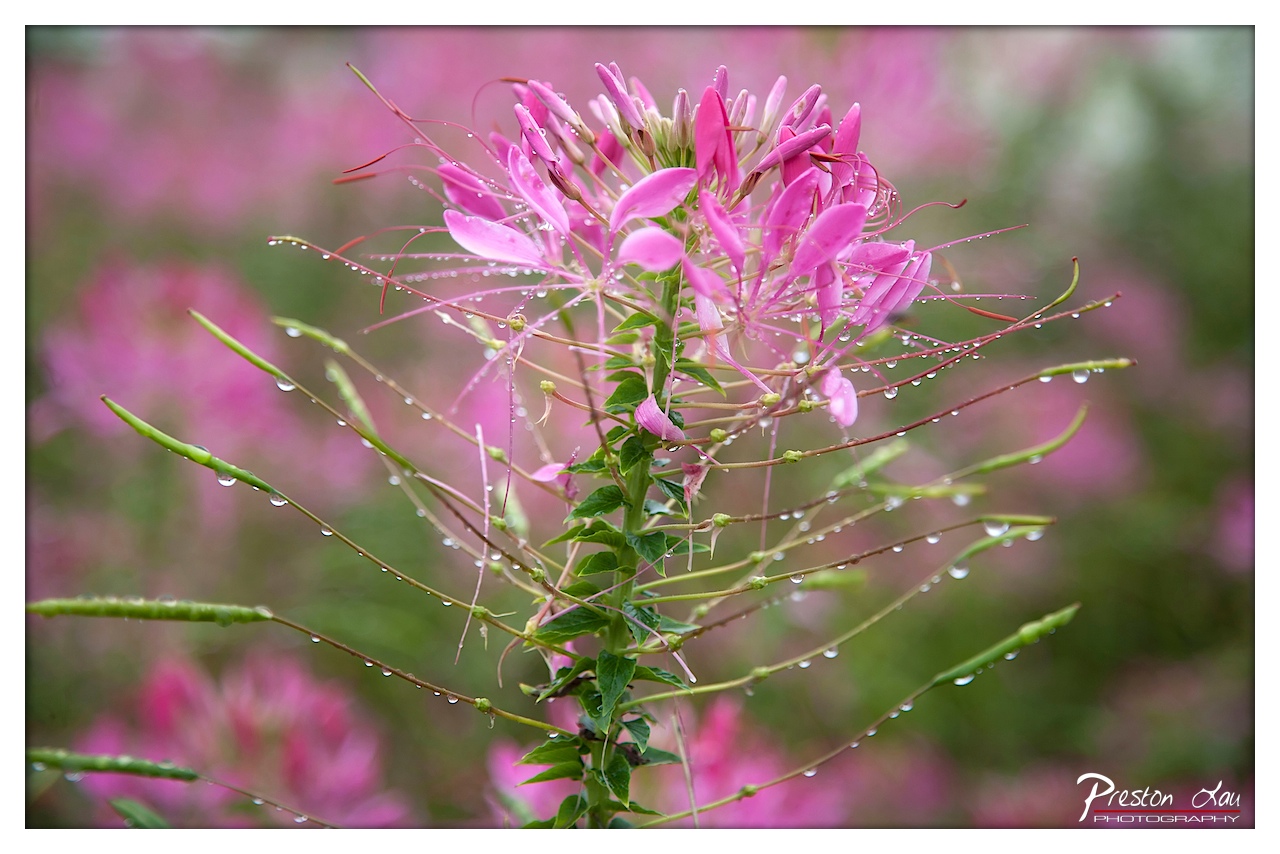

Spider Flower's Dewy Bling
Subject: 8/10
This photo features a fabulous pink spider flower (Cleome) doing its best impression of wearing a diamond necklace, thanks to a generous coating of water droplets. What's happening is essentially a floral beauty shot after a shower, showcasing the flower's intricate, spidery structure and the delightful glistening beads clinging to its stems and tendrils. The mood is one of fresh serenity and delicate beauty, almost as if the flower is sighing contentedly after a refreshing drink. Pertinent objects include the striking pink petals, the numerous slender stems, and the star players – hundreds of tiny, crystal-clear water droplets catching the light.
From a photography standpoint, the composition is classic and effective, centering the main flower head while allowing the droplet-laden stems to cascade outwards, creating leading lines and capturing interest. The lighting is soft and diffused, perfect for illuminating the water droplets without harsh reflections, lending a gentle quality to the scene. The color palette is a pleasing blend of vibrant pinks in the flower and the softly blurred background, contrasted with the rich greens of the stem and leaves. The style is clearly detailed nature close-up, utilizing a shallow depth of field to isolate the subject beautifully from the background blur, which hints at a lush field of similar pink flowers. Credit to Preston Lau for perfectly capturing those notoriously tricky-to-focus-on water droplets – they truly add a magical sparkle, making the flower look like it's dripping with jewels, and the creamy bokeh is just chef's kiss! While a slightly different angle might have added dynamic tension, the execution here is spot on for highlighting the delicate detail.
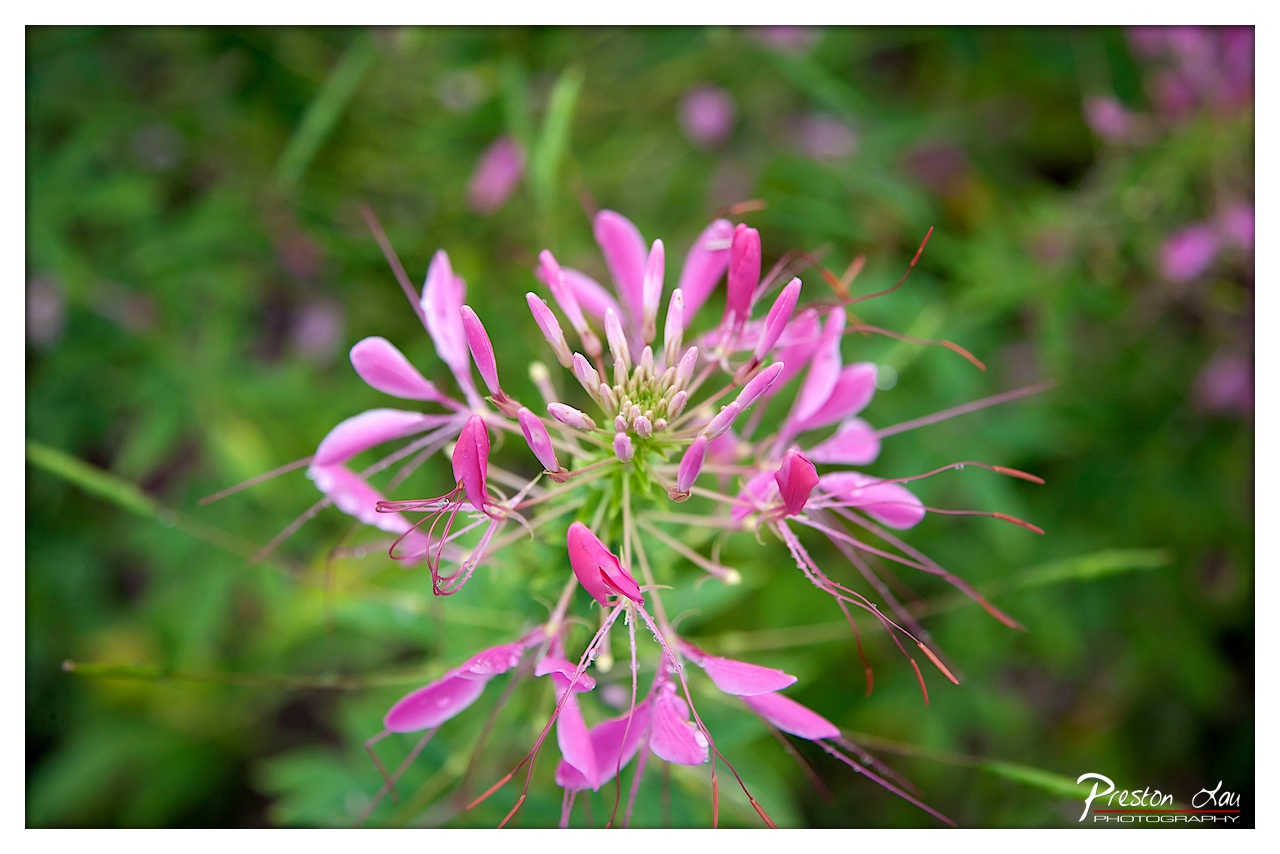

Pink Petal Explosion
Subject Rating: 7/10
This image presents a top-down view of a vibrant pink flower, likely a Cleome or Spider Flower, captured in a close-up perspective. The subject, a complex cluster of petals and prominent, spidery stamens, dominates the frame, looking like a miniature floral firework frozen in time. Tiny water droplets cling to the petals and filaments, adding a touch of sparkle and freshness to the scene. The shallow depth of field effectively isolates the detailed flower head, giving the image a delicate and focused mood against the soft, abstract backdrop.
From a photography standpoint, the composition's high angle really highlights the unique radiating structure of the bloom, although it does flatten the sense of depth slightly. The color palette is wonderfully simple yet striking: the intense pink of the flower pops brilliantly against the painterly, out-of-focus green of the background foliage. The soft, diffused lighting is perfect for capturing the subtle textures and the glistening water droplets, showcasing the delicate details without harsh shadows. It's a straightforward style focusing on the beauty of a single, intriguing subject, proving that sometimes you just need a cool-looking flower and a bit of bokeh magic.
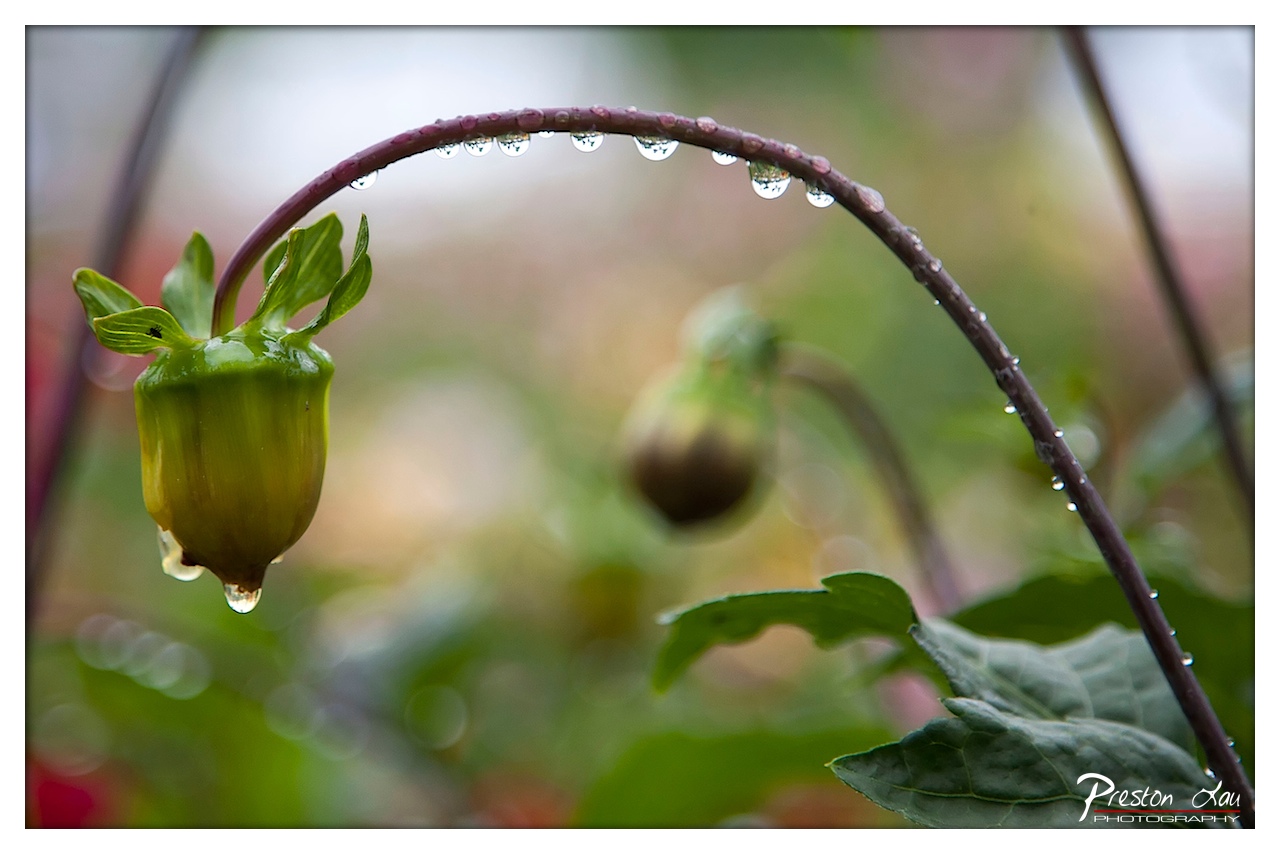

Waiting for the Bloom
Subject Rating: 8/10
This image captures a single, unopened flower bud, likely a dahlia based on the stem shape, hanging heavy and slightly bowed after a rain shower. The star of the show, besides the slightly sulky bud, is the stem arching gracefully, adorned with a string of perfect, glistening water droplets. It looks like the stem is wearing a delicate pearl necklace after a dip in the pool. The mood is quiet and reflective, perhaps a little melancholic, hinting at the patience required for growth or simply the gentle stillness after the rain has passed. The deep green bud is sharp and detailed, contrasting with the wonderfully soft, bokeh-filled background, which is a dreamy blur of greens, browns, and perhaps some distant warm tones, creating those lovely circles of light that make photographers sigh with contentment.
From a technical standpoint, the composition is strong, utilizing the diagonal line of the stem to draw the eye through the scene, leading down to the bud. The main subject is well-placed, not strictly centered, which adds dynamic interest. The lighting is soft and diffused – clearly ideal conditions for close-up nature photography, as it beautifully illuminates the translucent water droplets without harsh shadows. The focus is spot-on, sharp on the bud and the water-laden stem, while the background melts away, providing excellent separation and highlighting the subject. The colors are natural and muted, emphasizing the textures and details of the plant and the water. It's a classic nature macro shot that finds beauty in the small, temporary moments, like rain clinging to a stem, reminding us that even waiting can be photogenic. The discreet watermark in the corner confirms its photographic provenance.
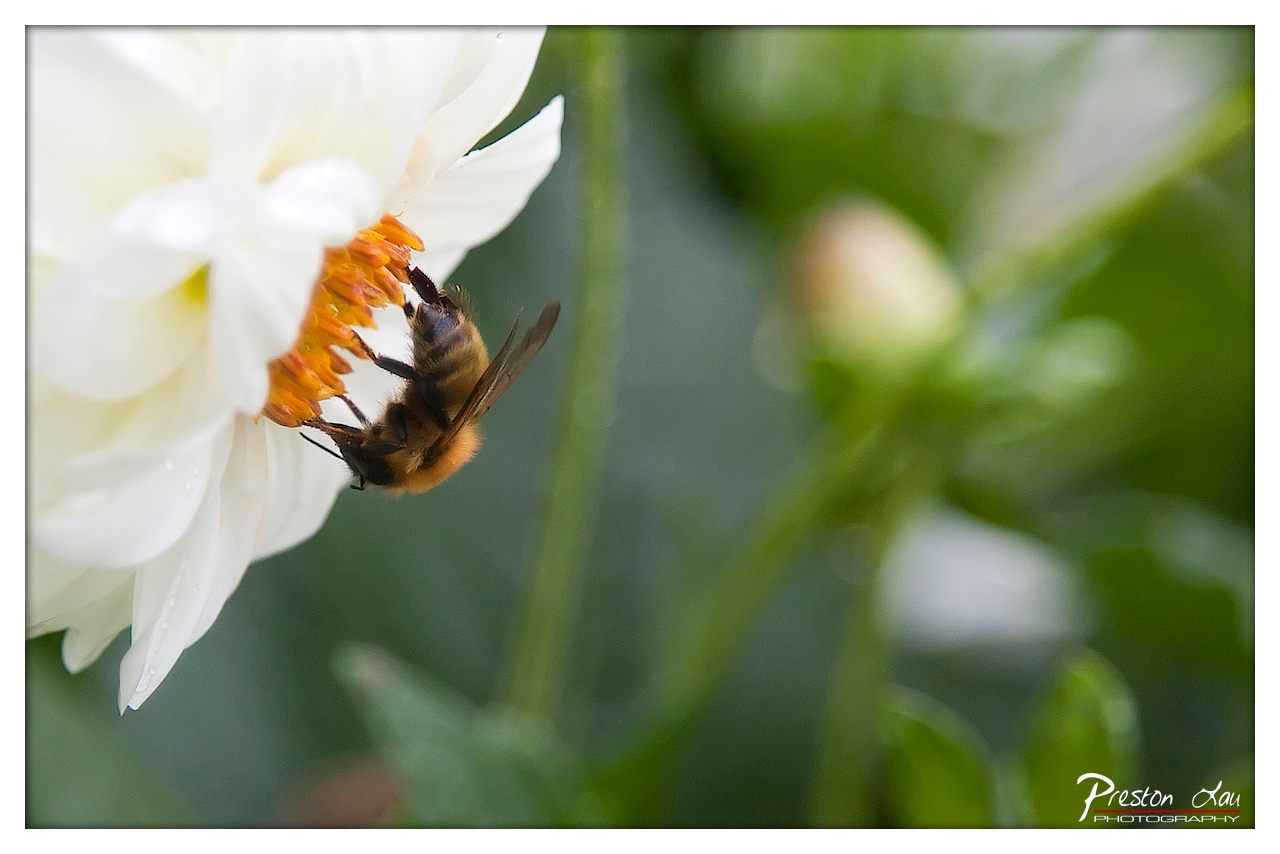

Nectar Extraction Specialist
Subject Rating: 9/10 (Highly dedicated bee!)
This image captures a moment of pure, focused industry: a fluffy European honey bee is absolutely buried headfirst into the bright orange heart of a white flower, presumably extracting some delicious nectar. It looks like the bee is performing a vigorous dive, its little furry rear end and folded wings sticking out for all the world to see. The mood feels peaceful yet quietly busy, reflecting the natural rhythm of a garden afternoon. Compositionally, the bee and the flower's center are sharp and prominent on the left, balanced by the wonderfully soft, blurred background. The lighting is gentle and natural, giving the scene a soft, inviting glow and highlighting the textures of the bee's fur and the flower's petals.
The style is clearly a macro approach, utilizing a very shallow depth of field to create that dreamy bokeh effect in the background. This blurry backdrop, a wash of soft greens and hints of other elements like a distant, out-of-focus flower bud, ensures the viewer's attention stays locked on our dedicated pollinator. The colors are vibrant but natural – the bright white of the petals, the warm orange of the stigma/stamens, and the deep black and amber of the bee contrasting beautifully against the muted green. It's a technically sound shot that effectively isolates the subject and tells a simple, engaging story about a bee's critical mission (and probably a tasty snack). The subtle watermark lets us know the artist behind this charming capture.
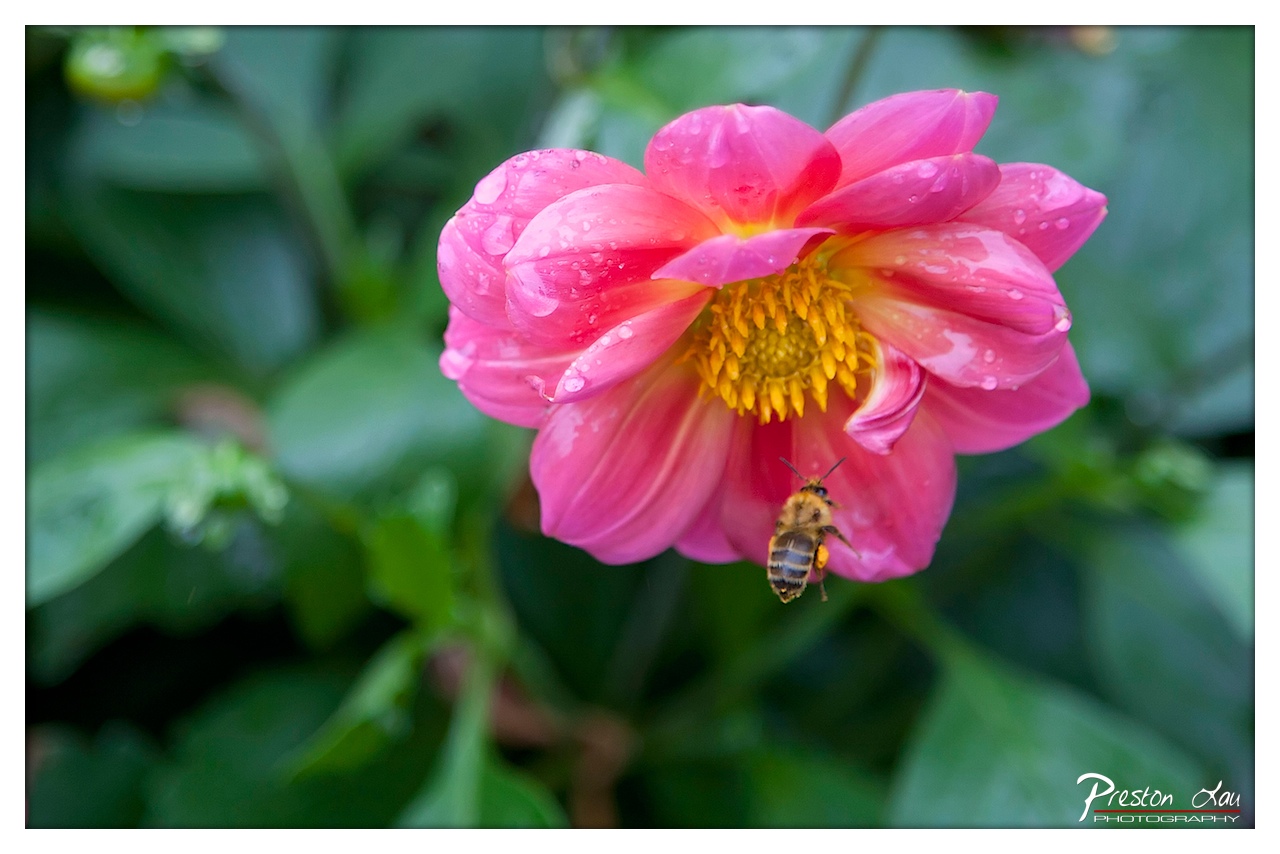

The Nectar Express
Subject Rating: 9/10 (Bees are arguably nature's most charismatic tiny workaholics, and this one is captured mid-flight!)
Looks like this little busybody is on a mission! The image captures a furry bee, buzzing towards a stunning pink dahlia, its legs laden with pollen – the ultimate power-up for the hive. The mood is distinctly busy and natural, set against a lush green backdrop that speaks of a damp, perhaps recent rain. The star of the show, the dahlia, is a vibrant splash of fuchsia pink with a striking yellow center, delicately adorned with shimmering water droplets. It's a close-up encounter, almost as if we're right there, watching the bee make its approach for a sugary refuel.
From a photography perspective, the composition is well-balanced, with the flower dominating the frame while the bee is strategically placed to suggest movement and purpose, leading the eye towards the bloom. The focus is sharp right where it matters – on both the bee and the intricate details of the flower petals and its center. The background is a beautiful, soft blur of green (that creamy bokeh!), which really helps the vibrant subjects pop forward. The lighting appears soft and diffused, likely from an overcast day, which is perfect for bringing out the rich colors and highlighting the tiny water droplets without harsh shadows. It's a lovely example of capturing a fleeting moment in nature with technical skill, showing great control over depth of field and a keen eye for detail, even down to the tiny beads of water.
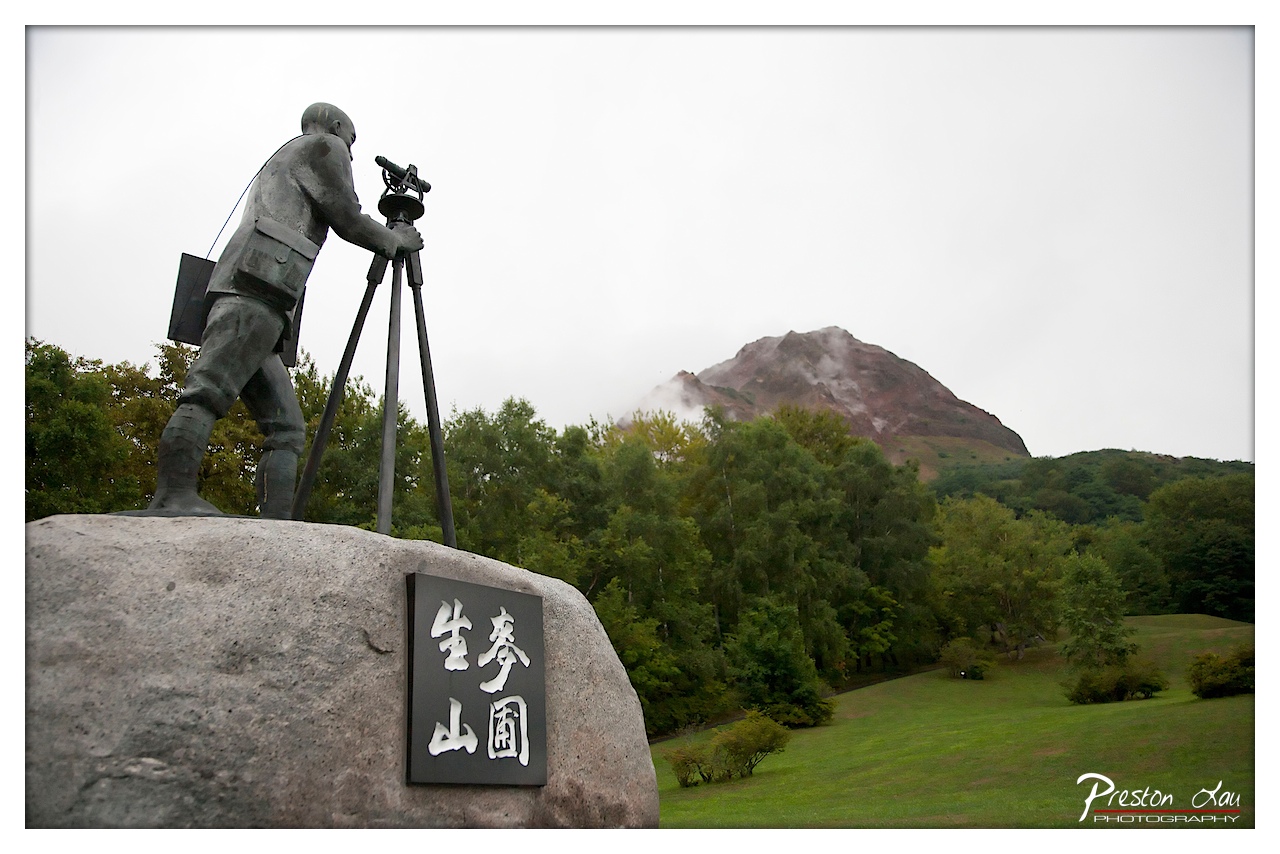

The Lone Surveyor Battling... Uh, Mist?
Rating: 7/10
Okay, so we've got a seriously dedicated bronze surveyor here, rated a respectable 8/10 for commitment to the job, come rain or (in this case) heavy mist. He's standing tall on a substantial rock, squinting through his fancy tripod-mounted gizmo (likely a theodolite, for all you surveying enthusiasts) at a moody, misty mountain in the distance. What's happening? Probably trying to figure out if the mountain has moved since the last time he checked, or maybe just mapping out the best picnic spot. The vibe is pretty contemplative, maybe a touch dramatic thanks to the mountain, but mostly just... quiet, like he's deep in thought, or perhaps regretting not bringing an umbrella. The scene is anchored by that big rock with some official-looking Japanese characters on a plaque, adding a touch of local flavor and significance.
From a photography standpoint, the composition is decent – the statue provides a strong foreground subject and leads your eye towards the dramatic backdrop of the mountain. However, the upper half of the frame is dominated by a rather uneventful expanse of grey sky, which is a common pitfall in overcast conditions. It leaves a lot of dead space where some interesting clouds or clearer visibility might have added more punch. The lighting is typical flat overcast light – soft, even, and perfect for avoiding harsh shadows, but let's be honest, it makes everything look a bit... well, flat. The colors are muted greens, greys, and the reddish-browns of the mountain, all perfectly natural but lacking pop. The background landscape is quite lovely, rolling green hills and trees leading up to the imposing, steaming peak, adding a nice sense of scale. It's a solid capture of a specific moment and place, capturing the historical connection to the landscape, even if the weather didn't exactly deliver peak drama. Sometimes you just gotta work with the light you're given, even if you're a bronze statue from the past.
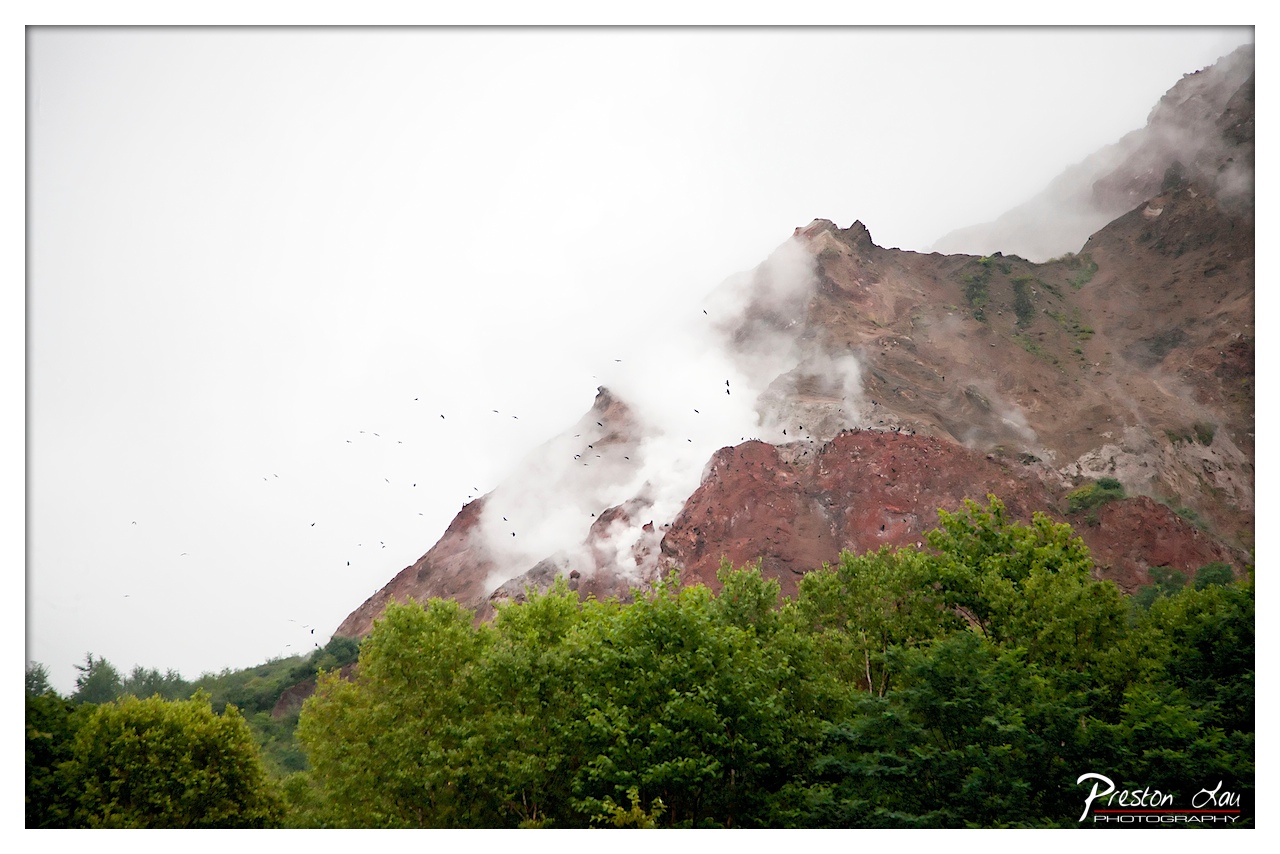

Steaming Peaks and Feathered Friends
7/10
Welcome to the geothermal bird sanctuary! This shot captures a dramatic volcanic landscape where a reddish-brown mountain is enthusiastically venting steam, looking like Earth's moody teenager having a vaping session. A bustling flock of small black birds adds a touch of chaotic energy, swirling around the steaming vents and perching precariously on the hot rocks. The lush green trees in the foreground offer a vibrant contrast to the rugged geology behind them. The overall mood is one of raw, untamed nature – it feels a bit eerie and primordial, like you've stumbled upon a secret meeting of mountain spirits and their avian messengers in the thick fog.
From a photographic standpoint, the scene offers fantastic subject matter. The composition cleverly uses the diagonal line of the mountain to draw the eye, and the foreground trees provide a nice bit of contrasting greenery to the ruddy rock and white steam, effectively grounding the scene. However, the bright, featureless sky is quite blown out, dominating the upper left and pulling focus – perhaps next time dial back the exposure a touch or bracket the shot, unless blindingly bright skies were the intended artistic statement (which is, you know, valid... maybe). While the overcast light softens the scene and enhances the misty atmosphere, that sky area is definitely losing highlight detail. The scattered birds, though small, add great dynamic interest, providing scale and a sense of life in this rugged environment. The rich, rusty reds of the mountain are the color heroes here, standing out beautifully against the ethereal steam and stark sky.
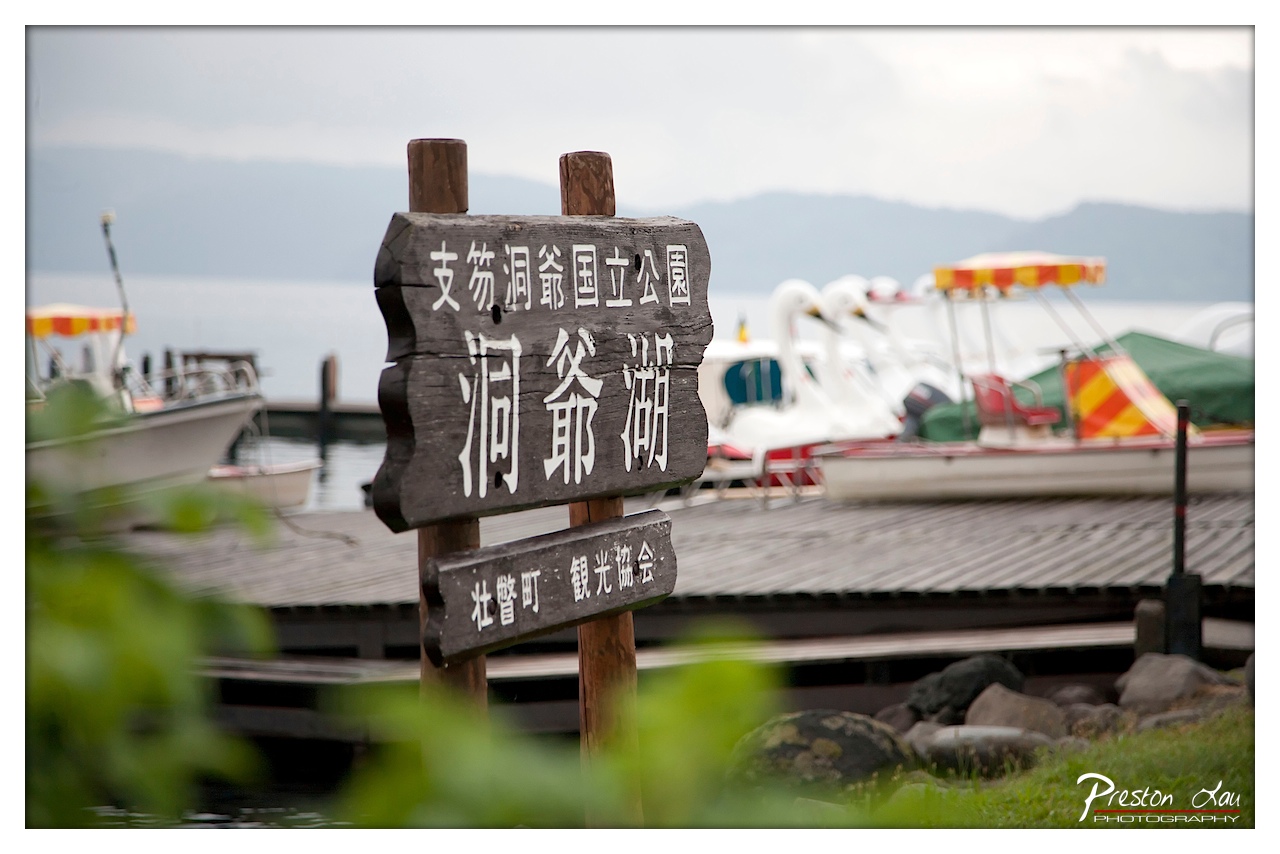

Lake Destination Signpost
Subject Rating: 7/10
This photograph presents a serene, somewhat overcast scene dominated by a weathered wooden signpost featuring Japanese characters. The sign, a sturdy structure of dark wood with crisp white text, stands prominently in the mid-foreground, hinting at the location's name and perhaps its significance. Behind the sign unfolds a peaceful vista of a calm lake surface. A fleet of boats is moored at a pier visible in the middle ground, notably including several charming white swan-shaped pedal boats alongside a more standard motorboat and smaller vessel. The mood is quiet and reflective, amplified by the diffused light of the cloudy sky and the gentle blur of the water. The foreground is softened by out-of-focus green foliage, adding a touch of depth and drawing the eye towards the main subjects.
From a photographic perspective, the composition effectively uses the sign as a primary focal point, positioning it slightly off-center according to the rule of thirds, which gives the image balance and allows the background scene to breathe. The shallow depth of field cleverly separates the sign and the boats from the blurred foreground leaves, achieving pleasing bokeh that directs attention where the photographer intended. The lighting, characteristic of an overcast day, provides soft, even illumination without harsh shadows – excellent for capturing details on the sign and reducing glare on the water, although it does result in a somewhat muted color palette. The contrasting bright white swan boats and the striped canopy add necessary pops of color against the predominantly grey and brown tones of the water, sky, pier, and sign. Overall, it's a competent travel shot capturing the essence of a lakeside tourist spot, managing to make a simple sign interesting by placing it within its tranquil context, complete with a healthy dose of whimsical swan boats.
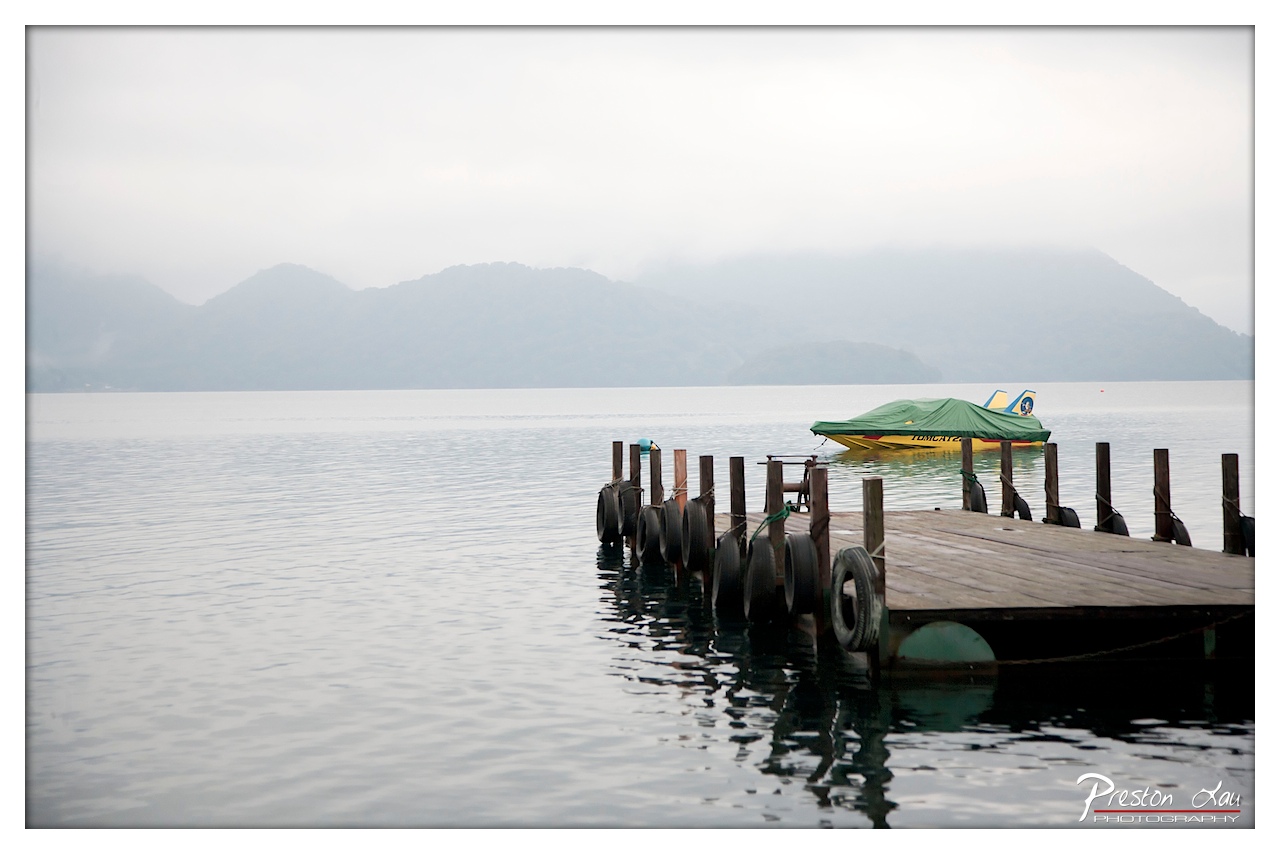

Misty Mornings and Sleeping Boats
Rating: 7/10
This photograph captures a quiet, misty scene on a lake, featuring a wooden dock extending from the right foreground towards the middle distance. Moored near the dock is a vibrant yellow boat, comfortably tucked beneath a protective green tarp, looking rather like it's having a little snooze. The water is calm, reflecting the muted tones of the sky and the dock elements, creating a serene, almost melancholic mood. The dock itself is rather industrial-chic, adorned with old tires used as fenders – practical, if not exactly picturesque. The backdrop consists of gentle, hazy mountains disappearing into the overcast sky, completing the tranquil, albeit somewhat dreary, atmospheric setting.
From a technical standpoint, the composition uses the dock effectively as a leading line, drawing the eye into the scene, although it feels a little cut off on the right. The boat provides a much-needed focal point and a splash of color in an otherwise very muted palette, which is dominated by greys, soft blues, and browns. The lighting is beautifully soft and diffused thanks to the overcast conditions, eliminating harsh shadows and perfectly capturing the misty atmosphere – it's like nature applied a giant softbox. While the lack of sharp detail in the distance contributes to the mood, some might find the overall image a bit flat. However, the gentle reflections on the water add a nice touch of depth and texture to the foreground, making it a well-executed study in capturing a quiet, atmospheric moment.
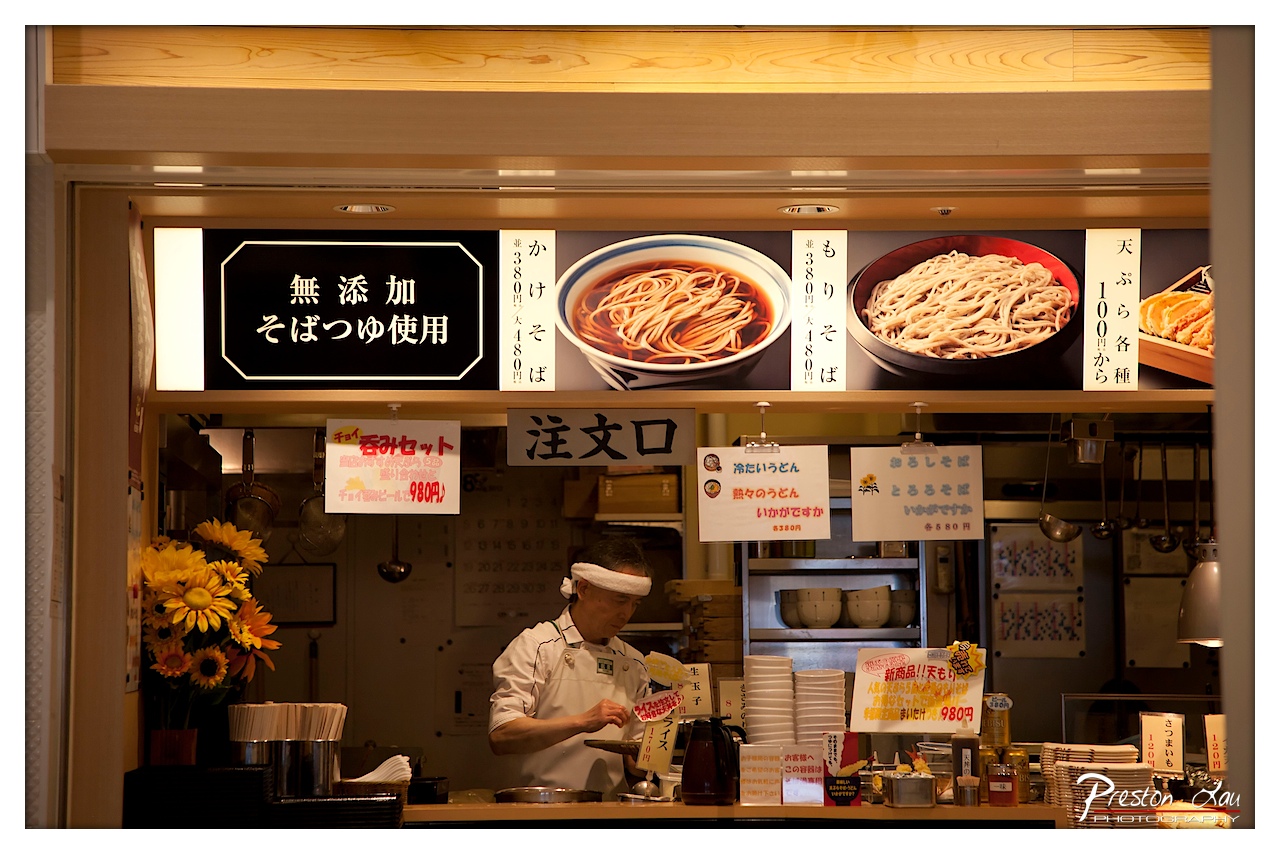

Noodle Shop Hustle
Rating: 8/10 (The bustling shop environment)
This vibrant image captures a moment inside a busy Japanese noodle shop, likely specializing in Soba or Udon as suggested by the bowls and signs. The central figure, a focused chef or worker in a headband, is engrossed in preparing an order at the counter, surrounded by the tools of his trade and stacks of waiting bowls. The atmosphere feels authentic and lively, reflecting the fast-paced nature of casual dining. Overhead, large signs display mouth-watering photos of the noodle dishes and important information, including a prominent sign stating "無 添加 そばつゆ 使用" (Additive-free Soba Soup Used), a point of pride or marketing. The overall subject matter is the everyday life and efficient operation of a small eatery, inviting the viewer into this slice of Japanese culture.
From a photography perspective, the composition effectively uses the shop's entrance as a natural frame, pulling the viewer's eye into the scene. The counter area is rich with detail, though perhaps a touch cluttered, but that adds to the realism. Warm lighting bathes the counter and the chef, highlighting the action, although the brightly lit signs overhead are quite dominant. The color palette is dominated by warm wooden tones and the inviting browns of the noodles, punctuated by the cheerful yellow of the sunflowers on the left – a surprising but welcome touch that softens the industrial feel. The style leans towards documentary photography, capturing a candid moment with a moderate depth of field that keeps the immediate foreground and counter area sharp while the background elements, like the calendar on the wall and kitchen equipment, fade slightly, adding depth to the workspace behind the chef.
Loading map...